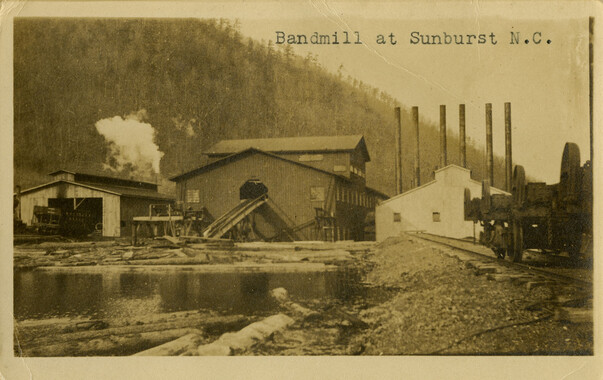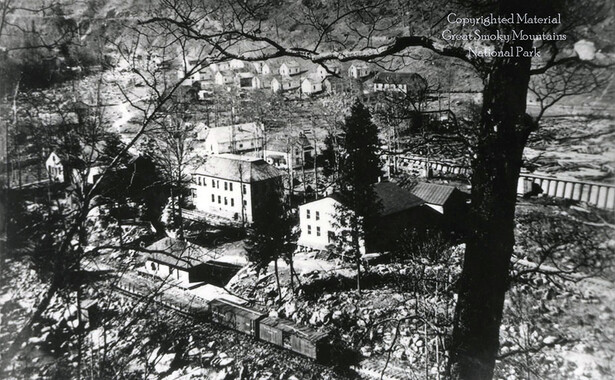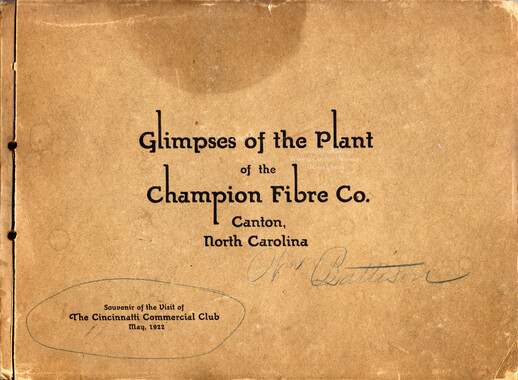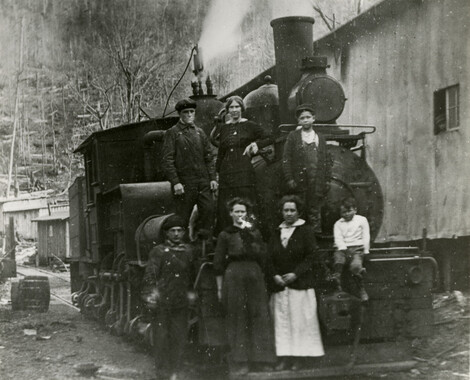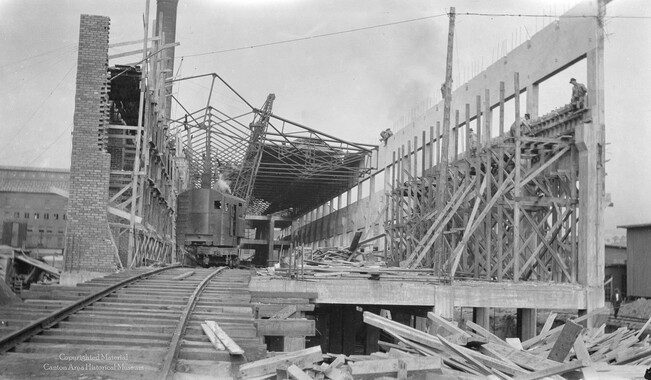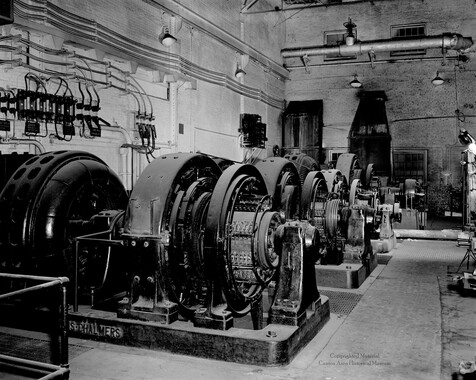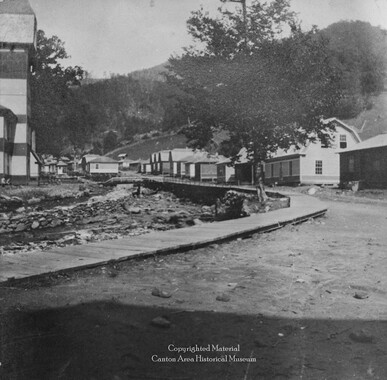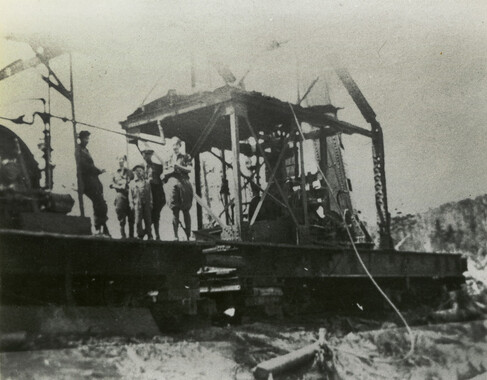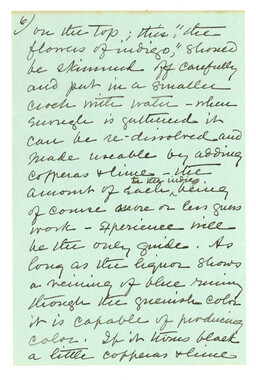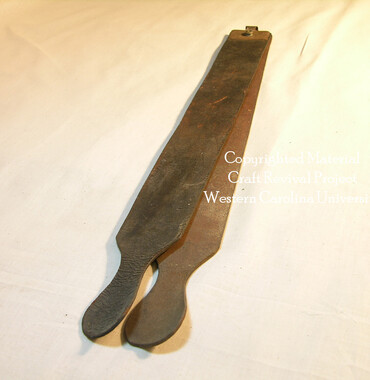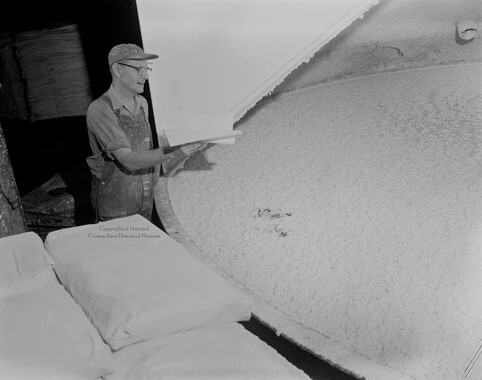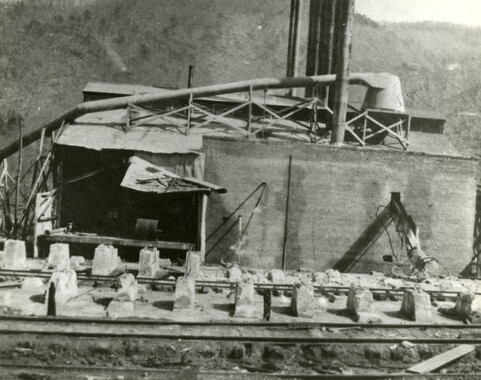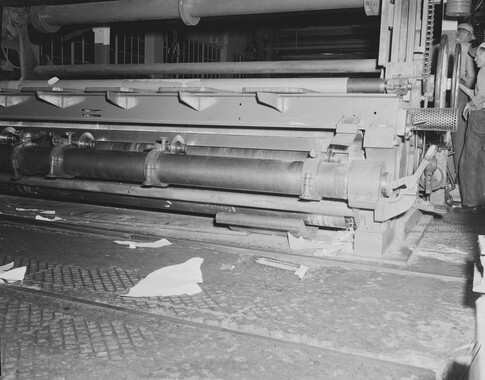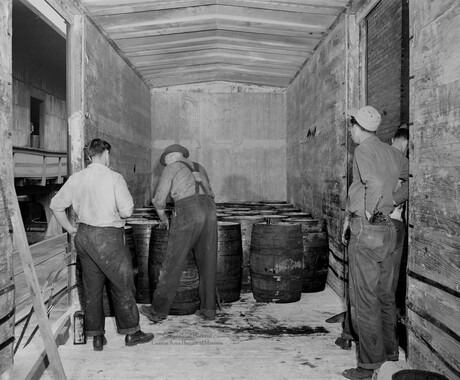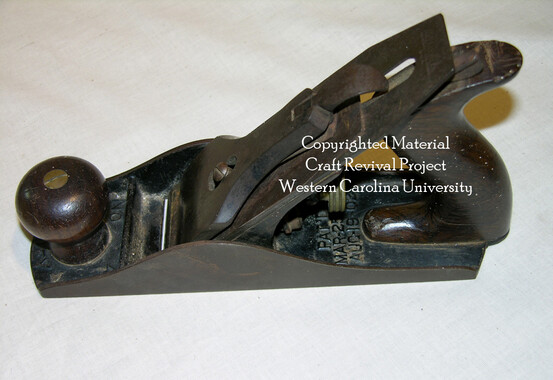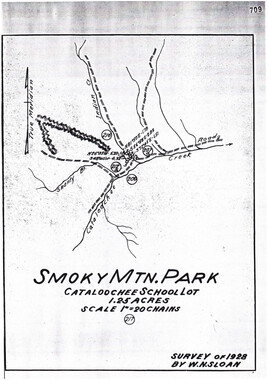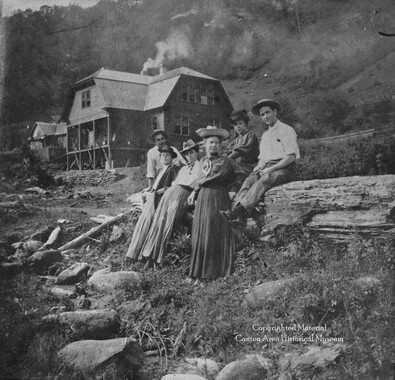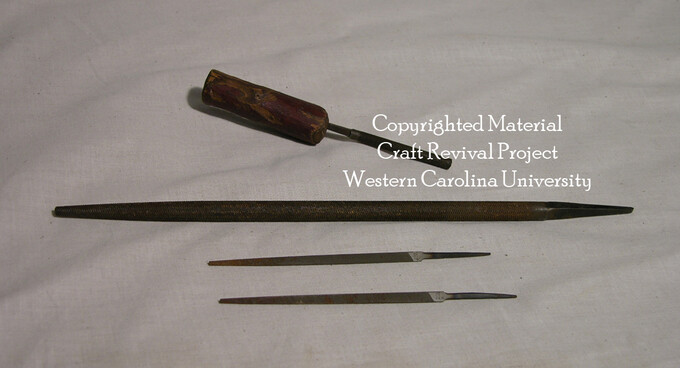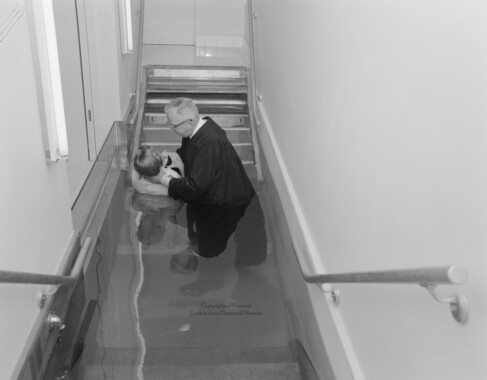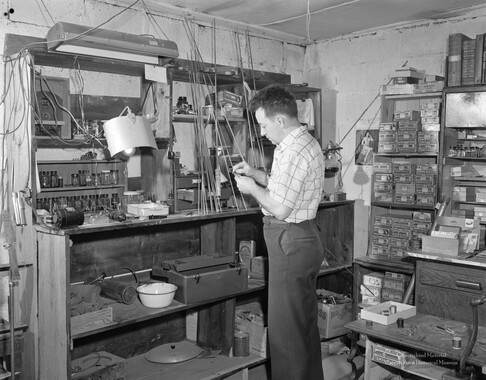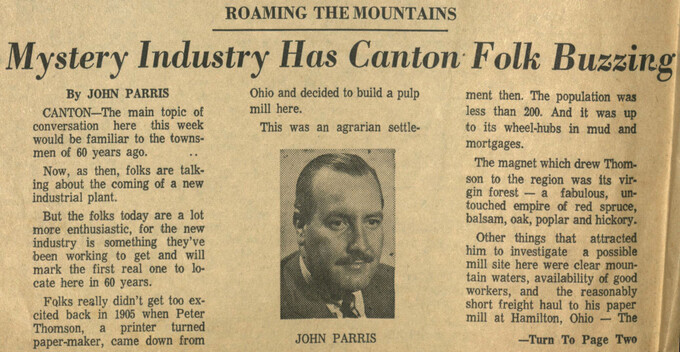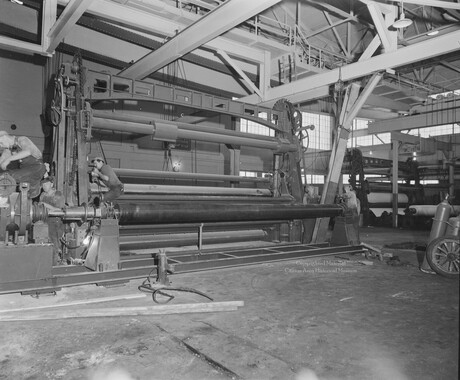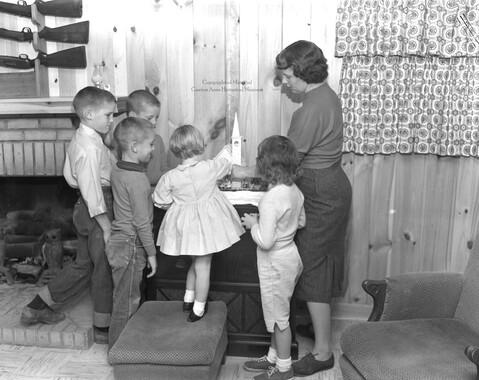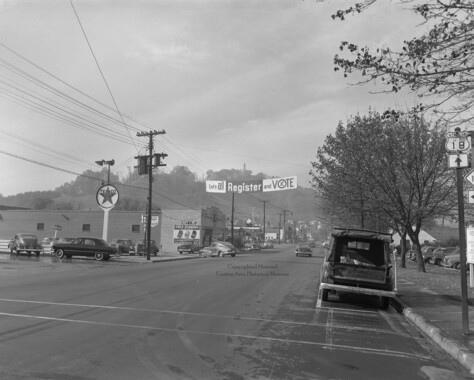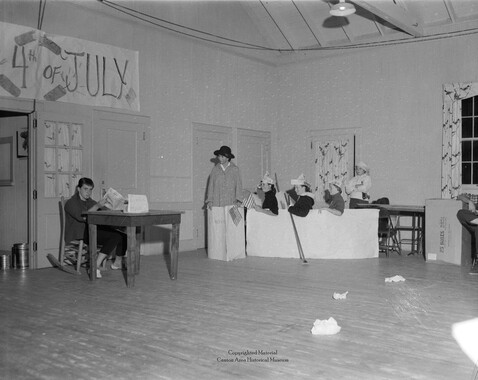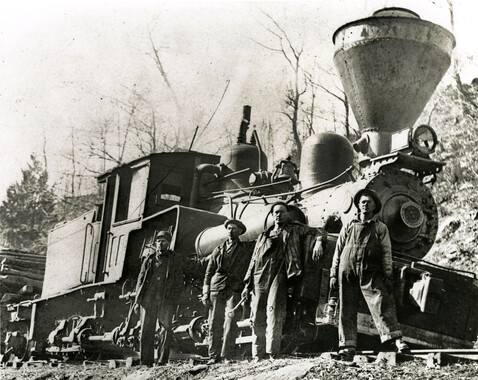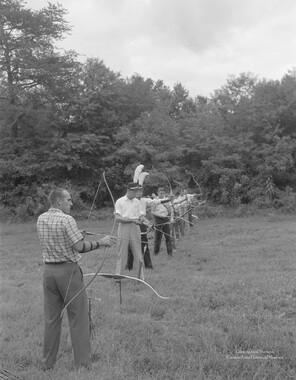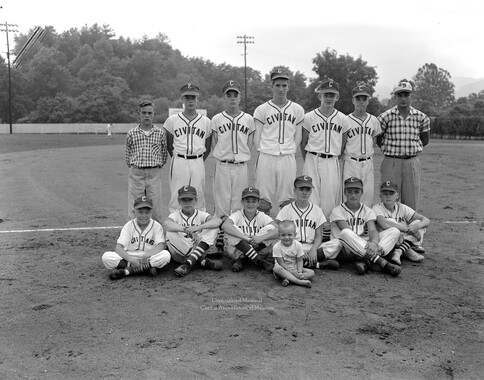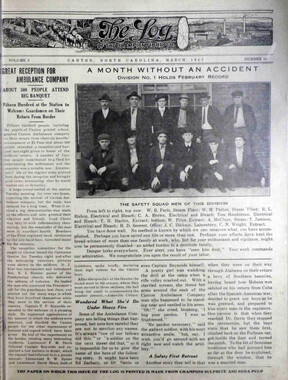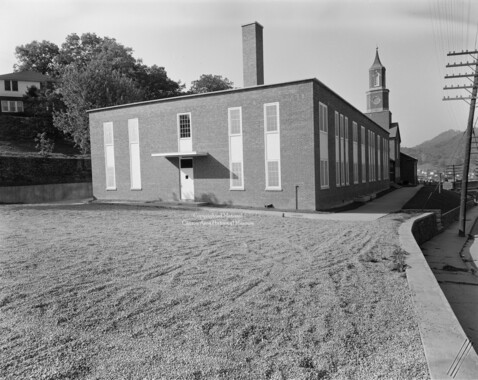Western Carolina University (20)
View all
- Canton Champion Fibre Company (2308)
- Cherokee Traditions (293)
- Civil War in Southern Appalachia (165)
- Craft Revival (1942)
- Great Smoky Mountains - A Park for America (2767)
- Highlights from Western Carolina University (430)
- Horace Kephart (941)
- Journeys Through Jackson (154)
- LGBTQIA+ Archive of Jackson County (19)
- Oral Histories of Western North Carolina (314)
- Picturing Appalachia (6679)
- Stories of Mountain Folk (413)
- Travel Western North Carolina (160)
- Western Carolina University Fine Art Museum Vitreograph Collection (129)
- Western Carolina University Herbarium (92)
- Western Carolina University: Making Memories (708)
- Western Carolina University Publications (2283)
- Western Carolina University Restricted Electronic Theses and Dissertations (146)
- Western North Carolina Regional Maps (71)
- World War II in Southern Appalachia (131)
University of North Carolina Asheville (6)
View all
- Allanstand Cottage Industries (62)
- Appalachian National Park Association (53)
- Bennett, Kelly, 1890-1974 (1295)
- Berry, Walter (76)
- Brasstown Carvers (40)
- Carver, George Washington, 1864?-1943 (26)
- Cathey, Joseph, 1803-1874 (1)
- Champion Fibre Company (233)
- Champion Paper and Fibre Company (297)
- Cherokee Indian Fair Association (16)
- Cherokee Language Program (22)
- Crowe, Amanda (40)
- Edmonston, Thomas Benton, 1842-1907 (7)
- Ensley, A. L. (Abraham Lincoln), 1865-1948 (275)
- Fromer, Irving Rhodes, 1913-1994 (70)
- George Butz (BFS 1907) (46)
- Goodrich, Frances Louisa (120)
- Grant, George Alexander, 1891-1964 (96)
- Heard, Marian Gladys (60)
- Kephart, Calvin, 1883-1969 (15)
- Kephart, Horace, 1862-1931 (313)
- Kephart, Laura, 1862-1954 (39)
- Laney, Gideon Thomas, 1889-1976 (439)
- Masa, George, 1881-1933 (61)
- McElhinney, William Julian, 1896-1953 (44)
- Niggli, Josephina, 1910-1983 (10)
- North Carolina Park Commission (105)
- Osborne, Kezia Stradley (9)
- Owens, Samuel Robert, 1918-1995 (11)
- Penland Weavers and Potters (36)
- Roberts, Vivienne (15)
- Roth, Albert, 1890-1974 (142)
- Schenck, Carl Alwin, 1868-1955 (1)
- Sherrill's Photography Studio (2565)
- Southern Highland Handicraft Guild (127)
- Southern Highlanders, Inc. (71)
- Stalcup, Jesse Bryson (46)
- Stearns, I. K. (213)
- Thompson, James Edward, 1880-1976 (226)
- United States. Indian Arts and Crafts Board (130)
- USFS (683)
- Vance, Zebulon Baird, 1830-1894 (1)
- Weaver, Zebulon, 1872-1948 (58)
- Western Carolina College (230)
- Western Carolina Teachers College (282)
- Western Carolina University (1794)
- Western Carolina University. Mountain Heritage Center (18)
- Whitman, Walt, 1819-1892 (10)
- Wilburn, Hiram Coleman, 1880-1967 (73)
- Williams, Isadora (3)
- Cain, Doreyl Ammons (0)
- Crittenden, Lorraine (0)
- Rhodes, Judy (0)
- Smith, Edward Clark (0)
- Appalachian Region, Southern (2393)
- Asheville (N.C.) (1886)
- Avery County (N.C.) (26)
- Blount County (Tenn.) (161)
- Buncombe County (N.C.) (1664)
- Cherokee County (N.C.) (283)
- Clay County (N.C.) (555)
- Graham County (N.C.) (233)
- Great Smoky Mountains National Park (N.C. and Tenn.) (478)
- Haywood County (N.C.) (3522)
- Henderson County (N.C.) (70)
- Jackson County (N.C.) (4692)
- Knox County (Tenn.) (25)
- Knoxville (Tenn.) (12)
- Lake Santeetlah (N.C.) (10)
- Macon County (N.C.) (420)
- Madison County (N.C.) (211)
- McDowell County (N.C.) (39)
- Mitchell County (N.C.) (132)
- Polk County (N.C.) (35)
- Qualla Boundary (981)
- Rutherford County (N.C.) (76)
- Swain County (N.C.) (2020)
- Transylvania County (N.C.) (247)
- Watauga County (N.C.) (12)
- Waynesville (N.C.) (68)
- Yancey County (N.C.) (72)
- Aerial Photographs (3)
- Aerial Views (60)
- Albums (books) (4)
- Articles (1)
- Artifacts (object Genre) (228)
- Biography (general Genre) (2)
- Cards (information Artifacts) (38)
- Clippings (information Artifacts) (191)
- Crafts (art Genres) (622)
- Depictions (visual Works) (21)
- Design Drawings (1)
- Drawings (visual Works) (184)
- Envelopes (73)
- Facsimiles (reproductions) (1)
- Fiction (general Genre) (4)
- Financial Records (12)
- Fliers (printed Matter) (67)
- Glass Plate Negatives (381)
- Guidebooks (2)
- Internegatives (10)
- Interviews (811)
- Land Surveys (102)
- Letters (correspondence) (1013)
- Manuscripts (documents) (619)
- Maps (documents) (159)
- Memorandums (25)
- Minutes (administrative Records) (59)
- Negatives (photographs) (5735)
- Newsletters (1285)
- Newspapers (2)
- Occupation Currency (1)
- Paintings (visual Works) (1)
- Pen And Ink Drawings (1)
- Periodicals (193)
- Personal Narratives (7)
- Photographs (12982)
- Plans (maps) (1)
- Poetry (5)
- Portraits (1657)
- Postcards (329)
- Programs (documents) (151)
- Publications (documents) (2237)
- Questionnaires (65)
- Scrapbooks (282)
- Sheet Music (1)
- Slides (photographs) (402)
- Sound Recordings (796)
- Specimens (92)
- Speeches (documents) (15)
- Tintypes (photographs) (8)
- Transcripts (322)
- Video Recordings (physical Artifacts) (23)
- Vitreographs (129)
- Text Messages (0)
- A.L. Ensley Collection (275)
- Appalachian Industrial School Records (7)
- Appalachian National Park Association Records (336)
- Axley-Meroney Collection (2)
- Bayard Wootten Photograph Collection (20)
- Bethel Rural Community Organization Collection (7)
- Blumer Collection (5)
- C.W. Slagle Collection (20)
- Canton Area Historical Museum (2110)
- Carlos C. Campbell Collection (282)
- Cataloochee History Project (65)
- Cherokee Studies Collection (4)
- Daisy Dame Photograph Album (5)
- Daniel Boone VI Collection (1)
- Doris Ulmann Photograph Collection (112)
- Elizabeth H. Lasley Collection (1)
- Elizabeth Woolworth Szold Fleharty Collection (4)
- Frank Fry Collection (95)
- George Masa Collection (173)
- Gideon Laney Collection (452)
- Hazel Scarborough Collection (2)
- Hiram C. Wilburn Papers (28)
- Historic Photographs Collection (236)
- Horace Kephart Collection (861)
- Humbard Collection (33)
- Hunter and Weaver Families Collection (1)
- I. D. Blumenthal Collection (4)
- Isadora Williams Collection (4)
- Jesse Bryson Stalcup Collection (47)
- Jim Thompson Collection (224)
- John B. Battle Collection (7)
- John C. Campbell Folk School Records (80)
- John Parris Collection (6)
- Judaculla Rock project (2)
- Kelly Bennett Collection (1314)
- Love Family Papers (11)
- Major Wiley Parris Civil War Letters (3)
- Map Collection (12)
- McFee-Misemer Civil War Letters (34)
- Mountain Heritage Center Collection (4)
- Norburn - Robertson - Thomson Families Collection (44)
- Pauline Hood Collection (7)
- Pre-Guild Collection (2)
- Qualla Arts and Crafts Mutual Collection (12)
- R.A. Romanes Collection (681)
- Rosser H. Taylor Collection (1)
- Samuel Robert Owens Collection (94)
- Sara Madison Collection (144)
- Sherrill Studio Photo Collection (2558)
- Smoky Mountains Hiking Club Collection (616)
- Stories of Mountain Folk - Radio Programs (374)
- The Reporter, Western Carolina University (510)
- Venoy and Elizabeth Reed Collection (16)
- WCU Gender and Sexuality Oral History Project (32)
- WCU Mountain Heritage Center Oral Histories (25)
- WCU Oral History Collection - Mountain People, Mountain Lives (71)
- WCU Students Newspapers Collection (1744)
- Western North Carolina Tomorrow Black Oral History Project (69)
- William Williams Stringfield Collection (2)
- Zebulon Weaver Collection (109)
- African Americans (388)
- Appalachian Trail (35)
- Artisans (521)
- Cherokee art (84)
- Cherokee artists -- North Carolina (10)
- Cherokee language (21)
- Cherokee pottery (101)
- Cherokee women (208)
- Church buildings (166)
- Civilian Conservation Corps (U.S.) (110)
- College student newspapers and periodicals (1830)
- Dams (95)
- Dance (1023)
- Education (222)
- Floods (60)
- Folk music (1015)
- Forced removal, 1813-1903 (2)
- Forest conservation (220)
- Forests and forestry (917)
- Gender nonconformity (4)
- Great Smoky Mountains National Park (N.C. and Tenn.) (154)
- Hunting (38)
- Landscape photography (10)
- Logging (103)
- Maps (84)
- Mines and mineral resources (8)
- North Carolina -- Maps (18)
- Paper industry (38)
- Postcards (255)
- Pottery (135)
- Railroad trains (69)
- Rural electrification -- North Carolina, Western (3)
- School integration -- Southern States (2)
- Segregation -- North Carolina, Western (5)
- Slavery (5)
- Sports (452)
- Storytelling (245)
- Waterfalls -- Great Smoky Mountains (N.C. and Tenn.) (66)
- Weaving -- Appalachian Region, Southern (280)
- Wood-carving -- Appalachian Region, Southern (328)
- World War, 1939-1945 (173)
Sunburst Story
-
Larry Mull, the son of R. H. Mull trestle builder, grew up in the logging community of Sunburst in Haywood County, North Carolina. His 202 page manuscript, with a forward by Andrew Gennett III, relates stories of Sunburst (now Lake Logan), while it was in operation from 1907 to 1926. Also included are remembrances of the flood of 1940 as it effected Cullowhee, North Carolina. The numbering is not always reliable so the table of contents below includes page numbers as they appear in the manuscript followed by page numbers of the pdf in parenthesis. Chapter 1 P. 1 (9): Lumberjack heritage Chapter 2 p. 15 (23): Switchback, railroads and trestles. Chapter 3 p. 25 (33): Steam locomotives Chapter 4 p. 37 (45): Logging camps Chapter 5 p. 48 (56): Overhead cable skidders Chapter 6 p. 58 (66): Timbercutters Chapter 7 p. 64 (72): The new double bandmill Chapter 8 p. 69 (77): The new Sunburst Chapter 9 p. 90 (98): Lumber camp schools Chapter 10 p. 112 9121): Moonshining and mountain ramps Chapter 11 p. 120 (129): U. S. soldiers in sunburst in 1918 Chapter 12 p. 139 (148): Human interest stories Chapter 13 p. 143 (154): (Devero) Sandford Devereaux Hamilton (September 1889-April 23, 1959 Chapter 14 p. 147 (158): He was the company store handyman Chapter 15 p. 155 (166): Reuben B. Robertson Jr. Chapter 16 p. 157 (168): Courtship and pranks Chapter 17 p. 160 (171): Fire destroys Sunburst bandmill Chapter 18 p. 163 (174): The Champion Lumber Company declares bankruptcy Chapter 19 p. 166 (177): A second Suncrest Lumber Company is organized in 1926 Chapter 20 p. 169 (180): The end of Sunburst Chapter 21 p. 172 (183): The great flood Chapter 22 p. 187 (199): The great Manassas mauler trained here.
-
-
ABOUT THE AUTHOR Larry W. Mull defies any filing system yet invented. In the first place, he is for birth certificate purposes, William Lowery Mull, the youngest son of Reuben Harrison Mull, the great trestle builder, and Mary M. Burrell Mull of Waynesville, North Carolina. His natural endowments are adequate to support an abundance of self-esteem; author, newspaperman, music teacher, gospel song writer, historian, geneaolgist, restaurantuer and a well known musician. He has more ingeneous talents than any one person I have ever known. Larry, due to his father's trade, spent his childhood in the unique lumber town known as Sunburst, at the confluence of three-pronged Pigeon River in Haywood County, where he received his early education under the tutorship of the colorful Professor Thomas Deaver, Professor J.E. Willia, the Missess Lydia Osborne and Oberia Wilde. He later worked for Suncrest Lumber Company and Blackwood Lumber Company, and, with all this knowledge and background, he writes with feeling and accuracy about the history and customs T of logging camps, mountain railroading and bandmills during the great days of the early twentieth century. His knowledge, gained from years of research and experience is exact, and he captures a colorful period of history which has been little documented. He was a member of the famous Soco Gap Dance Team and Band who entertained President Franklin D. Roosevelt, his wife, Eleanor, and the King and Queen of England in the 1930's. Larry is a good friend of mine, and was to my father, Andrew II, the founder of Gennett Hardwood Lumber Company, which still operates in the city of Asheville, North Carolina. It was my great pleasure when Larry optioned me to write these few words concerning his life and works. Andrew Gennett III, President Gennett Hardwood Lumber Company Asheville, North Carolina TT P R E F A C E Will there ever be any more humoresque lumberjacks? No. What do you me*an by new h umor? The witticism herein, created on the spur of the moment by the oldtime lumberjacks may be old, but the concepts are original. Anyone can devise new wit, but it takes imagination to recycle what's been said already. The very word lumberjack, conjures up images of the brawny, roistering outdoorsmen, who took fierce pride in their conquest of America's wild and rugged forest lands in the great Appalachian Mountains. So it was, in the unspoiled mountains of western North Carolina during the early logging days, when life was simple and hard; and so it remains sevently five years later, when life has become far more complex and difficult. The stories herein are true factual accounts of actural events that took place in western North Carolina's ten far western counties: Buncombe, Transylvania, Henderson, Haywood, Jackson, Swain, Graham, Macon, Cherokee and Clay. This is my initial attempt at compiling the history of the lumber industry dating back to the 1800' s. These stories are true factual events that took place at Sunburst (now defunct) at the confluence of three-pronged Pigeon River in upper Haywood County. This is the story of austere, robust men who blazed trails where few, if any, had gone before. It is not embellished by my own imagination as the years go by, because a spade is a spade, and I wore mine out digging into the past some thirty or forty years ago. It was my greatest satisfaction to be able to secure III these facts from those who were in-the-know passed on; facts that would have been buried in the forests forever and ever. This is a rich heritage that should be documents in the leading universities, ^colleges, schools and l ibraries for future generations, a historical event that will never appear again in this world. In our present day of social independence and selfish individuality, I am often forced to reflect on those years I spent in the thriving lumber town of Sunburst and East LaPorte. Those of us who lived in those quaint lumber towns that seem to gr ow up almost overnight learned that "togetherness" was a necessity for our existance and happiness. Togetherness touched our lives in many ways. We lived in company look-a-like houses that lined both sides of the boardwalks; we bought our food and other necessities at the same company store and attended the same churches and schools; we worked for the same company. Doing things together provided us with a happy means of survival during the 1930's. Only fond memories remain the the hearts of the very few living who worked at Sunburst. The noisy bandmill had a resounding whistle that bellowed at a periodic precision during the day. It acted as our time piece, signallying when it was time for us to "rise and shine." It sent the workers to their respective jobs in the bandmill, the planing mill, blacksmith shop, lumberyard and offices and the children off to school. A blast was set off at twelve noon for lunch hour, and at five o'clock to release the tired workers for IV a well deserved rest. It was a peaceful kind of noise that provided a tranquility that let us know when all was well. Today, however, our national forests have made a great comeback, lush and* green; and trees of every specie — save one, the lowly chestnut which is gone forever — are stretching their long fingers towards the clouds. But never again will our forests be endangered by their weird overhead skidders, groundhog slcidders, locomotives and r ailroads. The long, curing wall of the Unaka Range rising from the foothills at Hickory, North Carolina like a rampart, comprises 440,000 acres of the richest surviving examples of what the whole continent forest of this country was before the white man discovered America and set his hand at carving a new civilization out of the primeval wilderness. A big portion of the thick forests, once growing all over the Eastern United States was damaged somewhat, but the virgin ranges of the Great Smokies, the Blacks, Cataloochees, Pisgahs and Nantahalas were very little touched and are sanctuaries for trees, wild animals and fowls. The beauty and loveliness of these stupendeous mountains are still as elegant as they were back when the axmen made their assault upon the wilderness. The romancer's pen and the artists brush have attempted to portray with equal beauty the scenery of this "Land Of The Sky," but never have succeeded in describing its beauty in picturesque lovliness, grand and imposing majesty, awe-inspiring natural rugged beauty, the wonder in all its character where the virgin forests seem to say "A harp for every wind, a voice for every v sky." The loveliness of one thousand waterfalls dashing over cliffs at 20 to 60 foot drops is refreshing to the v ision of the visitors; this* land where nature has known no change, felt no decay for untold ages in this ancient land; her dark woods wave, I her rivers hold their way, majestic as when first from nature's hand; down the dread paths, as in the dawn of time, raging cataracts their waters urging. Silhouetted against a backstop of the bluest and most transparent skies, their mountains and sylvan scene is the fountain of the purest and most exilerating of atmospheres, a delight to inhale, a luxury to breathe. The horizon is lighted with a flashing radiance which is infinitely sublime, while the whole landscape is aglow with splendor, every tint and hue imaginable seems to intermingle in that sea of color, and every jutting crag, and dome, and pinnacle of sullen rock flames as though a thousand rainbows has fallen out of the sky and hung themselves there like glorious banners, you stand enthralled at the scene before you, no sound is heard, no note of bird breaks the awful stillness. You are in the region of eternal silence which wraps the summits of the "Everlasting Hills," a silent repose broods over the lofty peaks which still retains the last rays of the setting sun, while over the world below twilight has fallen. "How fair this lovely scene, And yonder dropping fiery ball, And eve's sweet spirit which steals unseen With darkness over all." VI Even though you are now convinced that you could never vies all the wonders of these Blue Ridge Mountains, you want to return again and again. One of the greatest spectacles ever beheld is that of a glorious sunset from many of these heights. You will never forget the scene before you when you stand by the grave of Dr. Elisha Mitchell at the peak of which he founded and bur ied there at his request, and look down that scene of resplendent glory that lays before you; far in the west the solden sun slowly sinks in a bed of crimson and gold. The massive wall is just ah ad, and as you wind around the range that crosses numerous wate falls dashing in foaming cataracts or tumbling over cliffs in sizzliig cascades into pools fifty and sixty feet below. At the last tu n the door of Newfound Gap opens abruptly into the rock terrace on the wall which is installed a bronze plaque that reads: "The park was given one-half oy the people and states of America and one-half in memory of Laura Spellman Rockefeller by the Laura Rockefeller Foundation by her husband, John D. Rocker-feller." Many moons before the white man ever set foot on this soil, the ancient Cherokee Indians made the mountains their home. Because of the heavy blue mists that hovers around them, the native Indians named them "Egwa Dutsuada Gaturi!" translated, Great Smoky Mountins. The name was sacred to Chief Junaluska who, on the "Trail of Tears, tearfully exclaimed: "Aye uyjusti Egwa Dutusi," (I love Great Smoky Mountains). VTI S U N B U R S T S T O R Y L U M B E R J A C K H E R I T A G E It is interesting to note that the expansion of the lumber industry was reflected in the record number of lumber companies operating simultaneously in the far western counties of North Carolina from the late 1890's to the 1 930's. Early in this period occured an influx of several hundred capitalists, seeking fame and fortune. They liked what they saw! More than 60 peaks over 6,000 feet high, over 100 more than a mile high, and hundreds more more than 5,000, clad to their very summits in dense forests, ribboned with 600 miles of clear spring-fed creeks, whose branches often ended in high roaring waterfalls. It is also gratifying to note that the great horde of lumber barons were representative of — besides North Carolina — South Carolina, Tennessee, Georgia, Florida, Mississippi, Alabama, Louisiana, Virginia, West Virginia, Maryland, Ohio, Pennsylvania, New Jersey, Connecticut, Minnesota, Missouri, Massachusetts, Delaware, New York, and New Mexico, as well as five foreign countries — Canada, England, France, Italy and Germany. Those influential capitalists, who turned North Carolina into the most lucrative and successful lumber capital in the world included 64 m^jor lumber companies, plus many more smaller companies. To name most of them: Champion, Suncrest, Gennett, Bemis, Ritter, Blackwood, Norwood, Kitchens, Andrews, Montvale, Jackson County, Sylva, Glouster, Carr, French, English, Whiting, Parsons Pulp & Lumber, N.C. Lumber and Land, Pigeon River, W.C. Hennessee, Denning and Powell, Boise, Kaiser, Kanawa, Bolding, Zickgraf, Shay Brothers, Hipps Brothers, Blue Ridge, Babcock, Epps and Baumgarner, Kitchens, Commonwealth, Alarka, Hampton, Long and S nyder, and Gandi and Motes. The major lumber companies also owned several subsidiaries, operating under various names. These were export firms, largely catering to British and South American trade. Some dealt in export trade on a much larger scale than most of the then existing companies. Most giant manufacturing companies believed in long-term profits and practiced forestry and re forestation; whereas others, considered such trivialities inconsequential and showed little respect for the land and forests. Their logging operations destroyed beautiful forest lands, causing serious erosion and other environmental problems. Hills were flattened, wilderness blitzed, and the land devastated. The first growth harvested included even the smallest trees and undergrowth. We may assume that those men were completely unconcerned about the dangers involved in such crude methods of operation! 2 The human race could not long survive without trees. Among other services, trees absorb and recycle millions of gallons of water — water which falls from the heavens to replenish the oxygen supply ^necessary for their survival. They also help to prevent devastating floods and erosion, refurbish the soil with valuable nutrients, act as wind-breakers, and provide a measure of protection for birds and f orest animals. One large stockholder was heard to advise his cutting crew: "Men, cut every bit of spruce you see, and don't leave one little sprig! Spruce makes greenback!" (Money, that is.) CHAMPION LUMBER COMPANY Among all the major lumber companies operating in North Carolina, from the fo othills at Salisbury to Clay County, bordering the state of Georgia, Champion Lumber Company had a record number of more than 2,000 employees during their operations in Haywood County. Owned and operated by Robert F. Whitmer, president, and sons, Frank R., Charles and William Whitmer, Champion first organized and existed under and by virtue of the laws of the State of Delaware, May 24, 1909. They moved to Pennsylvania and reorganized again, as shown recorded in Book Q and B in the Register of Deeds office in the Haywood County Courthouse in Waynesville, North Carolina, as follows: "Champion Lumber Company, State of Pennsylvania, County of Philadelphia: This is to certify that on the f irst day of September, 1914, before me the undersigned Notary Public in and for the County of Philadelphia, State of Pennsylvania, personally 3 came Robert F. Whitmer with whom I am personally acquainted, who being by me duly sworn says that he is president, and Fred H. Ely is secretary of Champion Lumber Company, the corporation described herewith, and who executed the f oregoing lease bearing date of the first day of September, 1914. Corporate Seal: Champion Lumber Company By R.F. Whitmer, President Filed: North Carolina Mercan File Co. Register of Deeds, Haywood County By means if a deed conveyed by W.H. Hannah, Trustee and Administrator for the Pigeon River Lumber Company, the Whitmer interests acquired an eleven thousand-acre tract of land, lying on the waters of the Cataloochee Creek, and Bi g Creek and their tributaries, February 23, 1911 and registered in the records of Haywood County in Book 31 of Deeds, page 170. This land was that portion of the Robert Love Speculation Lands, known as the Cata-loochees, Big Creek, and White Oak Boundary. It was conveyed by a deed made by Robert D. Gilmer, Trustee and Administrator for the North Carolina Land and Lumber Company, dated March 31, 1898, and r egistered in Book 10 of Deeds of Conveyance, page I, et. st. seq' in Haywood County Courthouse, Waynesville, North Carolina. Following the acquisition of these interests, Whitmer began buying up land and timber rights, for five and six dollars an acre from the earlier settlers on the three prongs of the Pigeon River. Among his many peers were three English brothers, Brice, James and Mark Reece, who owned extensive timberland. James, according to older timbersman once boasted that, "I own the 'mostest and be st' land of them all!" He was a man who believed that everything surrounding, involving or encroaching upon him in any way must have a name. After labeling a baren field above his cabin 'Potter Field' and the sight on which his cabin stood 'Boomer's End'* he designated a deep hold in the water of Middle Pigeon River 'Potter Hole.' Next he set out an apple orchard above his cabin and named it 'Potter Orchard.' He named the 5,274 foot mountain overlooking his domain Green Mountain and a ridge Black Knob and a shaggy area Brierfield. He set out two large apple orchards high on the mountain for commercial purposes and named them Sugar Cove and Turkey Cove. He later sold all his property to Champion Lumber Company and moved to Darrington, Washington, to hunt bear for the r est of his life. THE BEGINNING OF THE FIRST SUNBURST Champion Lumber Company President Robert F. Whitmer set up two circle saw mills at the confluence of three-pronged Pigeon River; a large mill with a nine-foot saw on East Pigeon, for sawing large logs; and a seven-foot saw on South Fork, for sawing small logs. However, transportation was slow and uncertain because of the isolated conditions and bad roads from the mill sites to Canton. Long stretches of roads were totally impassable for weeks at a time, both winter and summer, due to washouts, hub-deep mud, etc. Lumber was transported to Southern Railway at Canton on wagon trains, using as many as eight teams of horses. In an interview with the late Lloyd Rogers, (Champion's first sawyer), on his 94th birthday, Rogers recalled: 5 "I was sixteen years old, and su perintendent Samuel Montgomery Smith was taken aback over me being a sawyer at my age when I applied for the job, but nevertheless pleased with my sawing after giving iAe the test . You see, my father taught me to saw at the age of twelve. I sawed lumber ten hours a day six days a week on a rotating basis; one week on the big mill, and one week on the small mill. I sawed every board that went into the building of the lumber town at Boomer's End and also the Champion Paper and Fibre Company at Canton, now Champion International. And would you believe it — every board in that sulphite mill was A-grade spruce!" Champion erected some seventy or seventy-five houses along either side of the t hree-pronged Pigeon River for those who were to man their operations. They also built a large camp to accomodate more than one hundred workers, and named it Boomer's End Camp, later Camp One. Next, the erected a 40-room hotel, operated by Doug Wood and his wife, a commissary, both of which were destroyed by fire of undetermined origin in 1910. Eli Potter, a well known architect and builder, and Sa muel Montgomery Smith supervised the building of the town. Potter's comprehensive individuality was revealed in the t hree-story building at the base of 5,283-foot Green Mountain. On the ground floor, it housed a public school, a nondenominational church, a store operated by "Logger" Jim Shay and "Tanbark" Joe Shay, brothers, from Knoxville, Tennessee; also on the first floor was a forestry school, together with offices and living quarters for Dr. Carlos Alvin Schenck, of Germany, who referred to the ft building as the "finest school building in Wonderful. Western North Carolina." On the second le vel were a dance hall, skating rink over the church, as well as business quarters, meeting rooms for the Odd Fellows and Maso n Lodges, and a banquet room. The unusual building lifted its round three-story belfry among the ancient oaks and ch estnuts that stood on the mountainside behind its ponderous and modest in its scope and giant in size, compared to its neighbors, who should have fought to rescue this piece of Americana from oblivion! One remarkable aspect of the fancy building was an unusual stairway on either side of the entrance, leading up to the secon d level. As many as twelve persons could walk up the stairs side by side. There were kept waxed and shiny. There were no electrical facilities in the building nor in the town, since President Robert F. Whitmer was stricken with other plans. Instead, large ceiling gas lamps, which had to be taken down and "pumped full of breath," were used. (Families used kerosene lamps in their homes.) A spur (a branch of railroad track extending from the main line) ran to the back of these buildings to service the hotel and store. A flume ran along the south Pigeon River in the foreground to the standard gauge railroad tracks. On this, pulp wood was flumed directly into boxcars and tr ansported to the sulphite mill at Canton. A quarter of a mile up the Middle Prong of the Pigeon River, a spacious clubhouse housed the lumber buyers, business associates, and other clientele. It contained fifteen rooms. Here again 7 Eli Potter's ingenuity and inventive prowess were shown in the twelve-room house for the attendants of the clubhouse, at the base of Potter Field. In each of the four gables of the house he sculptured but a special design resembling a bright sunrise, which could be seen from far away. When it was finished, Potter looked at it and sai d: "This is my Sunbow Hou_se." It was this unique design that inspired Robert F. Whitmer to give the lumber camp the nomenclature Sunburst. Tom O'Knox owned the town's only barber shop. His bootblack was a one-eyed black, named Shady Howell, who liked to devise his own colloquial expressions and common jargon to spring on his jesting customers. Early one Saturday morning Bob Carver, a camp cook who was on his way to Asheville, stopped by for a quick shine. "Well," he asked, "How does my old friend, Shade, feel this morning?" Shade hesitated for a moment, thinking of a quaint answer, cleared his throat a time or two, and spoke ponderously, "Huh, paragorically speaking, I guess I feel adadodahigh. I think I'ze got de hydrofobia of a hoss'es essence." Later, the company, erected a large box factory to fu rnish employment for young women. The only men who worked there were Charles Marino, the superintendent, and young Walter Helmick. The girls were Miss Nola Warren, floor boss; Miss Ethel Battle; Miss Mable Gibson; and Misses Wilma and Mattie McFalls, sisters; Miss Laura Pressley; and the Misses Opal and Mable Sherrill, sisters. 8 Apple boxes manufactured by the box factory were used by Barber's Orchard and oth er orchards in Haywood County and were sold to apple growers throughout the country. Zeb Knott^ a prominent merchandiser, obtained land from "Uncle" Brice Reese and built a private store below Sunburst. This was in addition to the company store, and the one operated by the Shay Brothers. Knott's store served everyone's needs. There was a wooden frame around the tall pot-bellied stove, in which he kept plenty of sand. To make his customers feel at home, Knott kept plenty of empty nail kegs near the stove for them to sit on, and cuspidors for those who chewed tobacco to spit in. Sometimes one of the men would spit the amber juice into the sand. When this happened, Knott used a small shovel he kept handy to shovel out the sand containing spittle. Knott's store had something special for the children that no other store had. In front of the building were chewing gum and candy slot machines with a figure of Happy Hooligan inside. When a penny was inserted into the slot, Happy Hooligan would tip the tin can hat from his head, and a slab of chewing gun or candy would pop out. Zeb Knott never had to swat a fly. He used old-fashioned flypaper, the sticky kind that yellowish-brown. It hung in long curls throughout the store. A plaque hanging on the wall carried these words: "We have been in business since 1910. We have cussed and discussed, pillaged, lied to and che ated. The only reason we are staying in business is to see what in the hell will happen Q next." A little farther down the road Jack Hipps and his wife, Fannie, ran a boardinghouse. Room and board was only one dollar a day; but boarders had to climb a flight of stairs on the outside of the building to reach their sleeping quarters on the second floor. Hipps also operated a taxi service and a barber shop so that his customers wouldn't have to to go C anton and Waynesville to get haircuts, shaves and baths. THE TENNESSEE & NORTH CAROLINA RAILROAD When Peter Gibson Thommasonof Ohio founded the Champion Paper and Fibre Company, with branches in Hamilton, Ohio, in Houston, Texas, and the present one at Canton, North Carolina, he named his son-in-law, Reuben Buck Robertson, a lawyer, to be president of the Canton plant. Finding that their remote scattered tracts of land were not sufficient for the needs of the sulphite mill, after scouting various areas, the two men succeeded in buying one thousand acres of timberland from the early settlers on the headquarters of Middle Pigeon River for five dollars an acres. When Robinson realized that the wagon trains then being used to transport pulp wood from there to his sulphite mill were lacking both in capacity and speed sufficient to supply their needs, he visualized a flume as a means of transporting the wood to the mill. It was then he realized that only a railroad would suffice. Knowing that company funds were too low to undertake such a costly task at the time, Robertosn entered an agreement with i n Robert F. Whitmer and son, of Champion Lumber Company, to build the road. The Whitmer's also agreed to supply the Canton mill with pulpwood from their mill at Ravensford, in Swain County and Mount Sterling in Haywood County. Their mills were their greatest assets at the time. The duty of acquiring the railroad rights-of-way was assigned to Reuben B. Robertson, who,withhis company's attorney, spent numerous weeks of traveling up and down Pigeon River Valley, "negotiating" rights-of-way agreements with the land owners. When negotiations were completed and co ntracts properly signed, Champion secured a well known contractor in Knoxville, Tennessee, who sublet the contract to the Yandell Brothers, also of Knoxville. When the railroad was completed, it was named The Tennessee and N orth Carolina Railroad, known locally as "The Peavine Railroad." W.J. Parks was its first president, and R.G. Rogers was superintendent. Champion then secured a franchise on the standard gauge railroad line and extended it as a standard gauge road to Beech Gap (whose elevation was 5,280 feet), near the Transylvania County border. Champion brought their ninety-ton Shay rod engine No. 1 from Ravensford to Sunburst to run as a mixed train from there to Canton, since it was too large to negotiate sharp curves on steep mountain railroads. Superintendent Rogers gave the engine the name of Tennessee Big Four. It had four pilot wheels in the leading truck, and four 38-inch driving wheels on the left side. James Miller was engineer on the Tennessee Big Four and Clifford Wright, fireman; James Green, brakeman; Louis Morris, 11 flagman; and Claude Jones, conductor. Jones was succeeded by Robert Love as conductor, who later became mayor of the town o f Sylva, North Carolina. Otto Kelley was depot agent at Canton, and Lester Buhgin agent at Sunburst. Stations along the route of the Big Four were Stamey Cove, Moore's Station, Pendland, Cecil, Retreat, and later Sunburst, Burnettsiding, Woodrow, and Spr uce. Small sheds or shacks along the route served as flag stations, and in each was a bench. Waiting passengers would pull a draw cord, which threw the flag over for the train to stop. Families living on this route were furnished another means of transportation — a jitney bus that ran on rails. It had a twenty-four seat capacity and looked like a street car. Arthur Hallett was the owner of the jitney, which was equipped with a gas engine that used kerosene as a fuel. It made daily trips, Monday through Saturday, from Canton to Spruce. One way fare was fifteen cents, and a round trip was a quarter. All these stations are now extinct, with the exception of Canton, the home of the largest manufacturing plant in the United States. Such puffing, smoke-belching conveniences as the TBF and other steam locomotives helped establish mountain railroads as main arteries of civilization. As the Big Four engine labored up the six to eight degree grade along Pisgah mountain, she swayed over the uneven rails. Her load consisted of a traditional red coach, a red caboose, a coal tender, a gondola car, boxcars, and a long string of steel skeleton cars. People along 12 the way learned to tell the weather by the mournful and muggy sound of the engineer's whistle. Just before the train reached Spruce, perspiring conductor Claude Jones, *would pull back the red velvet curtain in the passenger coach and a nnounce languidly: "Spruce, ladies and gentlemen, Spruce." He always wore the t raditional blue suit and a blue cap with a black bill. Engineer James Miller and fireman Clifford Wright dressed in characteristic striped overalls with jackets and caps to match, • nd, of course, red bandannas around their necks to ward off hot cinders flying from the open smokestack. When the tra in stopped, Miller and Wr ight climbed down from their lofty perches in the cab and proceeded to oil the wheel bearings, the sides, and valves of the Big Four, as the excess steam came whistling forth. Camp I served as a depot. School children of all ages and sizes liked to meet the passenger train. All the boys vowed right then and there that they would become engineers as soon as they finished high school, not realizing that it would take alot of study and hard work as a flagman, a brakeman, and a fireman before they could take the test to become an engineer. Once a woman who lived in Spruce, accompanied by her small son, went to do her Christmas shopping in Canton. With their arms full of Christmas packages, mother and son trudged to the little station depot in west Canton long before the train was scheduled to leave for Spruce. For the "umpteenth" time the w oman walked over to the 13 ticket window and called out to the a gent, who was busy in his office. The agent, showing a trace of agitation, walked up to the window. "Please, *Sir," the a nxious woman said. "What time does the train leave for Spruce?" "Lady, I've told you the schedule no less than four times," the agent growled with a fierce grimace. "Yes, I know you have, Sir; but my son here likes to see you come up to the caged window. He says it reminds him of a zoo!" she replied indignantly! 14 I II S W I T C H B A C K R A I L R O A D S A N D T R E S T L E S The asperity of more than eighty peaks in mountainous Haywood County, ranging from five thousand to six thousand feet in elevation, required the expertise of a host of experienced engineers and intelligent technicians to build many miles of switchback railroads during the great lumber boom in the early 1900's. Chief engineer N.S. Ted Rorison, Robert S. Smiley, and Nathan, Hute, "Pop", and Dewey Rogers pooled their ingenuity to accomplish a feat that others deemed "impossible." They flauted the laws of gravity by penetrating the rugosity barriers of near inaccessibility to lay railroads up forty to sixty degree grades on the upper reaches of three-pronged Pigeon River. The chief engineers realized that it was impracticable to survey and lay out a comparatively straight railroad path up slopes with forty to sixty degree grades. The steep hills, the streams, and deep ravines forced them to build roadbeds in zigzag 15 fashion, which caused many curves to be built at nearly a ten to eleven degree angle. As soon as the surveying and laying out of the railroad bed was completed, large forces of workers, known as "Swampers," began cutting down timbers and clearing a right of way for the roadbed. Following this phase of operation, railroad foremen, knowl locally as "section foremen," began building the railroads. Among others, Champion was fortunate in securing as foremen such skilled men as Robert Hall, Dee Breedlove, Jess E. Holcombe, George Franklin, Elisha Hawkins, Alex Gregory, Buck Ashe, Dean Carpenter, and John Gregory. Their crews were known as "gandy dancers" in lumberjack jargon. Steel rails came in various lengths from 39 to 60 feet, and were laid down in sections; hence the names of section foreman and section crews. Hand hewn cross ties were laid parallel at one-step intervals, or 21 inches from center to center. After the foremen saw to it that the standard gauge "four feet, eight and one-half inches wide" and the narrow gauge "three feet, eight and one-half inches wide" were correct, the workers next laid down eight-inch steel plates on the crossties on which the rails rested, and then spiked them down. The rails were fastened together by four-inch angle bars. Bolts were passed through the holes of the rails and angle bars, and nuts were placed on the bolts and bradded down to keep the rails from separating. A ballast of crushed rock, cinders, and other materials was placed beneath the ties and on the roadbed 16 for strength, stability of the t rack, the improved drainage, as well as for keeping down weeds. It was the section foreman's duty to keep up the roadbed, which included' land, bridges, trestles, culverts, ballast, crossties, rails, etc. The ghastly switchback affair that spread across the face of Green Mountain for almost a mile was the most precipitous piece of incline railroading in the United States. At a distance, trains operating to and fro looked as if they were going to meet each other in a head-on collision. The switchback was served with spurs (a short branch of railway track leading off the main line) and a "wye" for turning engines around where there were no turntables available. A frog and an X-shaped "ruse" permitted trains running on one track to cross the rails onto another track. Engines could switch from pulling a load of cars to pushing them when necessary. THE MILE AND ONE-HALF INCLINE Railroad foreman George Franklin was issued fifty men to clear a roadway up Green Mountain. Due to the time element and long hours that would be entailed in the project, Franklin decided to use extra heavy loads of dynamite to move tons of dirt and boulders off the mountain. From there the road would be built to 6,130-foot high Sam's Knob for Champion to harvest the heavy stands of virgin spruce in the area of the 13,000-acrea Shining Rock, and many other places along the route. 17 Franklin directed his men to dig three holes in the mountains at long intervals and place double loads of dynamite (an explosive compound of nitroglycerine and sa wdust) into them. He scheduled the *blast-off for six P.M., when all workers would be at camp. Only Franklin and James Gaddy (his powder monkey) would remain to set the charge for the blasting that would occur spontaneously. The date was Tuesday, July 16, 1912; when the two me n failed to return to camp, the foreman, Doug Wood, sent Percy Fowler, his cook, to check on them. The holocaust that met Fowler's eyes sent him into a wild, uncontrollable outburst of emotion: "Oh, no! It can't be!" he cried. Franklin and Ga ddy were blown to pieces. Since there were no eyewitnesses, it was philosophized that one of the holes had failed ot go off and the two men had gone back to investigate the reason. The detonation must have occurred the split second they reached the scene. Batteries were not used then — only fuses. "The only way we could identify the remains of the victims was that the blast blew my Uncle James apart from the waist up," explained Joe Gaddy, James' nephew. "We knew it was Uncle James because he had his name tattooed on his arm." Dr. Tom Stringfield, Haywood County Coroner, lived in Waynesville. It took several hours to transport him to the scene on a hand car. The coroner remained with the victims until they were shipped to their respective homes for burial, Gaddy to Canton and Franklin to Franklin, North Carolina. 18 The incline was finished that same year. Champion set up a gigantic machine on a flat in the Black Knob area to operate the incline, made possible through the expertise of machinist Chester Lee Hawkins (the inventor of the overhead skidder carriage) and his able forces in the machine shop. The monstrous machine was equipped with an extra large steam boiler, a giant drum holding more than five hundred feet of cable, a winch drum, a whistle, and other assets. It was encased in a pillar of cement and guyed to "dead man" trees in all directions. Two brothers, Garret and Greenlee McFalls, engineered the machine. They pulled up steam locomotives, steel skeleton cars, log loaders, railroad steel, lumber, and all other materials needed to move timber and build complete camps and railroads in the area. When the railroad reached Big Sam's Knob, Camp No. 17 was built between Big Sam's and Little Sam's Knobs. The scenery of the roaring waterfalls over outcropping cliffs and the jagged gorges and mountains throughout the area was enough to make the lumberjack's hackles stand straight up. Since the terrain was too rugged for horses and oxen to operate in, overhead skidders provided the muscles for harvesting the timber. The vibration of the cables, trembling and wavering against each other and the cliffs, made a singing, sizzling, screeching, slapping sound. "Some of the biggest logs ever cut in the Pisgahs came out of that area," vowed Alvin Ashe, of Tuckaseigee, a former skidder rigger. IP "The logs were so heavy they kept the skidder cables broken so fast we couldn't keep enough cable splicers," he pointed out. "There's not many of the old skiddermen left. I am one of the last," Alvin ^aid. "But we can finally relegate the happiness, hardships, the sorrows, and regret to a place where they belong— to history and the historians of a future day." When Champion finished harvesting timber in that area, a large ledgerwood skidder was left on Beech Gap to erode away. TRESTLES AND THEIR BUILDER As soon a chief surveyor, Ted Rorison, completed laying out a railroad bed, Reuben Harrison Mull, trestle builder, started on his building program. Also known by his initials, and by "R.H. Dodson", Mull was considered a great trestle man, when it came to using round timbers. Here was a man who could sit down by a ravine or look across a stream and, with only a level, a square, a plumbob, a "rule", pencil, and paper, figure out the distance and elevation across a ravine or stream. He sent his men to the wo ods with his figures; they sawed the timbers and hewed them with broad axes and foot adzes. When the timbers were pulled to the b uilding site by Mull's two yokes of oxen (named Matthew, Mark, Luke, and John), and then were set up, they "fit like a glove," William A. Bradley, superintendent, stated. "R.H., or 'Dutchman" Mull as I called him, was perhaps the only man in the entire country who was able to build trestles out of 'round timber'," Bradley added. The setting up (building) phase of the trestle was done with tackle blocks and rope and oxen. Horses could not be used because "they were too flighty", according to the builder. First Mull figured how many bins were needed, and then how many mudsills, posts, stringers, battery posts, and caps. He placed the mudsills at proper intervals and leveled them for the next phase. Then a true post or center post (straight) was placed on either end of the mudsill and bolted down. Next came the battery posts (fixed firmly as a support), one on either side of the true post, with the bow outside and slanted on a thirty-five degree angle at the bottom and bolted down. Stringer caps were then placed on these. The "stringers" (logs hewn flat, on which cross ties and steel rails were laid) were placed down and bolted. Bins were built around each of these networks and filled with rocks to retard high waters during rainy seasons. The builder then completed the trestle by a fancy network of cribbing (heavy boards crisscrossed from one bin to another), and the trestle was ready for the railroad crew to lay the steel rails. The cribbings, when the early morning sun shown through, presented a kaleidoscopic shadow across the hillside below. The section crews laid the nine-foot ties across the stringers at one-step intervals and bolted them down. Steel rails were then laid, gauged, and s piked down. Then the trestle was ready for the steam locomotive to travel over. The most unusual trestle Mull ever erected was on the left fork of Pigeon River and was known by lumberjacks as the "Horseshoe Trestle." The curve at the midsection of the tr estle resembled a horse shoe—thus its nickname. It was a three-decker, three hundred twenty feet long and ninety feet high. A humorous incident, which is still remembered by hundreds of former lumberjacks, happened on this trestle. A Georgia man, known only as "Buttermilk Joe", stayed in the logging camps for long stretches at a time before going out. He saved what loggers called "a good heel" to have a good time on. Then he journeyed into Canton to celebrate. He got himself a room in a hotel and a quart of whiskey and became a "jolly old lumberjack." Once, after a rambunctious two-week drunk, still wobbly and woozy, Buttermilk Joe decided to go back to work. Being somewhat confused, he wasn't aware of what day of the week it was. Thinking it to be Sunday and knowing that the locomotives didn't run on Sundays, he decided he would walk on the railroad to the woods. He stopped and took a little "nip" from his bottle along the way. Finally, he reached the famous Horseshoe Trestle and was walking along pretty well until he heard the shrill whistle of an oncoming train. Figuring that he couldn't beat the approaching train, he crawled down between the cross ties and seated himself on a stringer cap until the train has passed over. But, when Joe tried to pull himself back up through the cross ties, he found he couldn't make it, and was sure that in trying, he might fall to his death ninety feet below. He sat on the stringer cap until he dozed off to sleep, falling over, and almost plunging downward. He caught hold with both hands and held on for dear life. The first wave of shock was upon poor Joe, speeding up his pulse, turning his skin cold, making him shiver, and jarring him out of his wiqs. He was weak, and his mood wavered between hope and despair. Knowing he would fall to his death when the feeling left his fingers, he prayed. The darkest hour is just before the dawn. Daylight was creeping over the horizon when Buttermilk Joe, tears streaming down his face, looked downward for the last time. What he saw startled him. He was only four feet off the ground! He quickly let himself drop, physically drained, with about as much strength left in him as a butterfly's belch. The shock completely sobered him. Joe rubbed his hands and fingers vigorously, trying to generate some feeling into them, muttering feverently: "This is it! I'll never 'hit the bottle' again!" R.H. Mull accomplished an unbelievable feat in building a trestle on the Middle Prong of Pigeon River. The area presented a grisly situation. Holes had to be drilled in the slick cliffs on the mountainside and steel rods inserted into the holds on which he built the trestle. The steel rods still remain as proof of great intelligence. Mull's most unusual trestle was one at Ravensford in Swain County. That chef d'oeuvre (450 feet long and 125 feet high) was built in the Round Bottom area. People, especially women, who walked across the eerie-looking trestle, complained of losing their equilibrium. Besides, they were in danger of being caught in the middle of the trestle by incoming and outgoing loco-mo tive s. When Champion President, Robert F. Whitmer, heard of the womens' complains of "getting swimmy-headed" every time they looked down, he had the trestle floored from end to end. This also made it convenient for those living on the other side to cross over to shop at the company store and to visit relatives and friends. The United States Forest Service, on learning of R.H. Mull's building prowess, secured his services to erect fire "observation" towers throughout the Great Smoky Mountain National Park. Mull next went to Harlan, Kentucky, as a trestle builder for a lumber company there, later returning as a builder for Blackwood Lumber Company, where he worked until his retirement. At one time, he also built several trestles in the Pink Beds area for the Carr Lumber Company of Brevard. S T E A M L O C O M O T I V E S Champion Lumber Company had a dozen steam locomotives, which manufactured their own energy on coal—as much as 150 to 3000-horsepower. They were known as the old "Iron Horse" variety, which operated so successfully on steep mountain grades. The weights of the engines could be 35-, 40-, 70, or 90-ton (Shay, Climax and Heisler). A 35-ton engine, called a "goat", or "jack" was used as a switch engine on the lumberyard tracks, and the 40-ton engines were used mainly on narrow gauge railroads, far up in the mountsin. Each locomotive had a fancy "Cowcatcher" (also called pilot) in front to throw off debris, cattle, hogs, horses, and deer from the tracks, any of which could cause an accident if they were run over on the tracks. Especially dangerous and plentiful were the deer, which seemed to be mesmerized by the bright headlights on the engines. Engines were also differentiated by their wheel arrangement. Some had one or more pairs of small wheels (pilot wheels) mounted as a swivel truck in front of the engine, to guide it around curves. Similar pairs of small wheels could be found under the cabs. The engine types, by wheel arrangement, were numbered (e.g.', 2-4-0, 4-0-4, 4-4-0, etc.), so that the first digit was the number of pilot wheels, the second the driving wheels, and the third, those under the cab. The engineers controlled the amount of steam entering the cylinders by means of a throttle valve. The expanding steam pushed the pistons, which turned the cogged wheels, and changed the heat energy into rotary or back-and-forth motion. Each locomotive was equipped with a "ruse", known as a pneumatic sander operated by compressed air. The purpose of this "ruse" was to pour sand, in freezing weather, on ice-coated rails in order to lessen the trac tion of heavily loaded trains traveling down steep inclines. Several of the older model locomotives had open smokestacks, while the newer models (such as number seven, eight, and nin e Shays, and number ten and eleven Climaxes) were equipped with more fancy spark arresters and electric headlights. Shay rod engine Number 2, a 90-ton sidewheeler, was purchased from Parsons Pulp and Lumber Company, of Parsons, West Virginia, February 19, 1910. It had four pilot wheels in the leading truck and four driving wheels. Since it was too large to negotiate sharp curves, the company sold it to Central Lumber Company, of Laquine, Pennsylvania. It was later sold to Salem Brick and Lumber Company (Slidell and Lacombe Railroad), Slidell, Louisiana, and still alter to Newman Lumber Company, of Hatties- burg, Mississippi, where it was scrapped in 1949. It took two months to complete clearance regulations through Southern Railway to have the engine shipped to Pennsylvania. Shay stopped Manufacturing locomotives in 1925, when the new crude oil Diesel engine was introduced into the mountains. Shay Number 2102, a 70-ton engine, with 32' drivers, was bought by Pigeon River Lumber Company, at Crestmont, North Carolina; alter purchased by Champion and sold to Alarka Lumber Company, in Swain County. Joe Taylor was engineer on this and Hussy Barber, fireman. Shay Number 1 had a 10 x 10 cab, 38' drivers and was originally built for J.E. Potts, Sadet Lumber Company, of Osoda, Michigan. It was next sold to Haddock Lumber Company, Mount Sterling, North Carolina, then to France Lumber Company, and third to Hartford Supply Company for the Boise Hardwood Lumber Company, of Haywood and Jackson Counties, North Carolina. It ended its days at Yellow Pine Lumber Company, at Yellow Pine, Alabama. On this one Manse Jenkins was engineer and Rex Bearox, of West Virginia, fireman. Shay Number 5, a 70-ton, was bought by Champion at Crestmont and later moved to Spruce. Polly Darr, of West Virginia, was engineer and Ed Bennett, fireman. It was sold to Fouche River Lumber Company, of Fouche River Valley and Indian Territory Railroad, Bigelow, Arkansas, and then to Gloster Lumber Company, of Gloster, Mississippi, and Rosman, North Carolina. Mitch Hampton and N oah Haney were its engineers at Spruce. Shay Number 6, with 32' drivers, was bought by Champion February 13, 1912 and was moved first from Crestmont to Sunburst, and later to Waynesville. Tom Shoalt and Bi ll Maney were its engineers. Shay Number 7, a 70-ton, with Tye Jackson as engineer and John Johnson, fireman, was bought by Champion January 22, 1913. This locomotive also had the following engineers during its reign with Champion: Buck Benard, Alonzo Bullman, George W. (Skull-buster) Gibson, and Gilbert Harrison. It was moved to Waynesville in 1926. Shay Number 8, a 70-ton, with an 11x12 steel cab and 36' drivers, was engineered by Andy Long, while Louie Morris was fireman. It was bought by Champion at Crestmont, February 2, 1912 and moved to Sunburst. This punctual locomotive created much history during her logging days in Haywood County. Unfortunately, besides being a run-a-way once or twice, she ran over Ray Brooks in the lumber yard at Sunburst, killing him instantly. She was moved to Waynesville in 1926, where she ran there to Gobbler's Knob, at the head of Campbell Creek in the high Balsams. Rupert McHaffey was engineer on that run. Shay Number 9, a 70-ton with ah 11 x 11 steel cab, was engineered by Salem Collins with Don Hall as fireman. It was bought by Champion at Crestmont January 29, 1914 and moved to Sunburst. A mishap on this train took the life of Abraham Hamilton, brakeman, and Tom Queen, a contractor, September 22, 1924. Hugh Rabb, a brakeman, lost a leg in another mishap on December 31, 1924. It was moved to Waynesville in 1926. Climax Number 10, with Tom Shelley as engineer, weighed 70 tons and had 36' drivers. A narrow gauge engine, it ran from Raven's Gap and Beech Gap to the standard gauge railroad on Green Mountain. It was moved to Waynesville in 1926. Climax Nutaber 11 was a narrow gauge, 40-ton engine, engineered by Clyde Tallydee, of West Virginia, with Tom Shoalt as fireman. It plied to Beech Gap, lying at the edge of Pisgah Lodge, and joined Caney Fork Balsams in Jackson County, to the standard railroad. Co-workers used to jest with Tallydee, saying that he came from so far back in the We st Virginia Hills that he received the Saturday Night Grand 01' Opry on the radio a day late ! Climax Number 1, narrow gauge, was a 35-ton powerhouse, called a "donkey." It also had a modern spark arrester, couplers, electric headlight, pneumatic sander, and a cowcatcher. Move-over, it could and did push long strings of flatcars on the lumberyard while making up trains. When the locomotives completed their daily runs they were brought to the sw itchyard for inspection and refueling with coal and water by the "hostlers" for the next day's run. If they needed repairs of any kind, they were taken to the l ocomotive shop and worked on by expert repairmen. Nearly all of the larger companies had what was called a Roundhouse, which was a circular building containing a timetable. It was a large bridgelike track structure, which revolved on a pivot, so as to turn locomotives to a position over a pit, thus enabling the workers to make adjustments. Although this may seem hard to believe, I am told that it really happened to Rex Bearox, of West Virginia. He was working as an engine mechanic inside the boiler of a locomotive when someone came along and slammed the hatch door shut. Despite all the fra ntic banging he did on the door with his tools, no one was near etnough to hear hi m. Sometime later the hostler started a fire in the engine to get up s team. The imprisoned Bearox was filled with stark terror, realizing that if he wasn't rescued soon he would suffocate. "I cried and I prayed," he said. "Then I heard a faint voice calling: 'Cut the flames, Rex! Cut the flames!' I did just that with the few tools I had. The engineer, realizing that something was wrong, doused the fire and at length found the West Virginia "Snake" inside the boiler. He was about ready to "pay off the fi ddler" when he was rescued. Fear and shock had whitened his hair, but he was certain that he had heard the voice of the Lord directing him just what to do. STEAM WHISLES DID BLOW Every engineer had his own mode of blowing his whistle when nearing trestles, crossroads, schools, or villages; their individuality was such that those who knew them personally could recognize who was engineering an approaching train by the sound of his whistle. Engineers took so much pride in their skill of blowing their sonorous instrument that they bought their own. Some liked whistles which were keen and high-pitched in tone, while others preferred those of a low, monotone pitch. Tye Jackson and John Johnson, of Robbinsville, Norht Carolina, Salem Collins, and Andy Long were the connoisseurs of the rope whitle cords. Being real masters of the art, they could produce wonderfully soothing musical tones by tightening or loosening the ten sion of the cords. Many of tftiose pert engin eers learned to "swoon" the ladies by their whisle serenade. Tye Jackson's whistle, apparently a six-fluter calliope affair, seemed to play an unusual "Whippor-will" tune. Farmers and other weather prognosticators were able to prophesy the weather by the various tones of the whistles. When the engineers transferred from one locomotive to another, or to jobs with other lumber companies, they always took their whistles with them. When they retired, they removed their whistles and carried them home as a part of locomotive heritage, for they were a prized piece of Americana that money can't buy. "Nothing had so much romance, action, and even excitement as the old smoke-belching, huff-puffing Shay and Climax 'choo-choos' ," vowed Carl K. Jones, of New Bern, North Carolina—a "dyed-in-the-wool" lumberjack. "I can hear in my mind that doleful, screaming sound echoing on and on until it died away in the distance, and even then seemingly to linger in the air around me," he concluded. Mrs. Edna Nobles, also of New Bern, was just as enthusiastic: "Every time I hear the present Southern Railway whistle blow, it fills me with nostalgia for the old steam whistle during the great logging boom in the mountains. I used to listen, enthralled, to themusical tones of the engineers' whistles as the old 'chug-a-lug' locomotives labored up steep incline grades to the mountains, echoing and reechoing through the high hills and deep canyons,that game me a feeling of ecstatic pleasure." How sad that those days are gone forever, and can be lived only in memory! But thanks be to memory! What would warm the hearts of millions of American people as much as thebnews that the old coal-burning locomotives were making a comeback? The U.S. Energy Department is studying utilization of a new coal-burning locomotive to haul coal from the western coal fields. Even if this dream were to become a living reality, the locomotives would never compare to the old Shay, Climax, and Heislers of fifty years ago. Neither could they replace such colorful personalities as the old engineers. Along with Tye Jackson, John Johnson, Salem Collins, and Andy Long, there were others: Mitch Hampton, Rupert McHaffey, Gilbert Harrison, Clyde Talleydee, Tom Shelley, Alonzo Bullman, Louie Morris, Buck Benard, Joe Taylor, Adam Ruff, Manse Jenkins, House Ratcliffe, Buch Ashe, James Miller, Paul Sharpe, Tom Shoalt, Bill and Porter Crisp, Bill Haney, George Craig, and Rex Bearox. BIZARRE MISHAPS ON THE RAILROADS Steam locomotive railroad crews working twenty-to-forty degree railroad grades courted many tragedies and, yes, even death, while fulfilling their obligations as engineers, firemen, brakemen, and flagmen. A number of runaways of the Shay and Climax engines took place during the great lumber boom at Sunburst and S pruce, especially among the narrow-gauge engines. Inclement weather, such as blizzards and freezing rains, making the steel rails very slick, led to the pouring on of sand by an automatic pneumatic sander to give the locomotive more traction. The sand, creating friction, then made it appear as if great balls of fire were flying from the tracks. Still, th*e runaways took their toll at times from these hardy men, such as the almost legendary Casey Jones, who elected to stay on the engines despite the dangers involved. Buck Evans, of Tennessee, was one of these brave engineers. He stayed on a narrow-gauge Climax until it hit a spur switch and turned over, killing him instantly, on March 11, 1922. George Craig was killed by a runaway engine April 11, 1922. Ray Brooks, a worker in the bandmill at Sunburst, was run over and killed in the lumber yard. Tom Queen Tom Queen was a pulp wood contractor for Champion Paper and Fibre Company. His wife, Anna, was a very religious woman, who was forever begging him to accompany her to church on Sundays—but he never budged. At the breakfast table Sunday morning, September 21, 1924, Tom, after some hesitation, said to his wife: "Anna, I had a most unusual dream last night that I can't shake off." She asked him what it was and he said "Heaven. I dreamed I had died and went to heaven, and when I got to the g ate, St. Peter said, 'You can't come in'." "I looked inside and saw the most beautiful people I had ever seen in my li«fe." "What were they doing?" Anna wanted to know. "They were dancing and re joicing," Tom replied. Anna observed that her husband had a worried expression on his face, and with great concern, she said to him: "Tom, you must have had a premonition that something terrible is goting to happe n." Tom only sighed heavily, but said nothing more. Early the next morning (Monday), Shay locomotive Number 9, was on its way to the w oods, carrying an overhead skidder on a steel skeleton car. Just before it reached the long "S" trestle, the car derailed, sending two men to their death. Tom Queen and a companion, Abraham Hamioton, a railroad brake-man, were sitting in the skidder carrying on a conversation, while watching over a load of groceries to guard against their falling off. The car and skidder landed in a ravine several thousand feet below, killing the two me n instantly. The load of groceries was scattered everywhere. On March 3, 1924, a skeleton car, loaded with logs failed to couple on an engine and got away. It raced down the mountain for more than a mile before jumping the tracks, ramming into two shacks occupied by Mrs. John Maney and Mrs. John Shelton, killing them instantly. Mrs. Bill McGaha, who was living in the third shack received only slight wounds. However, her husband was killed on a runaway locomotive when a skeleton car failed to couple onto an engine and sped down the mountain. Bill McGaha, who had remained on the car, hoping to t ighten the brakes and stop the runaway, was killed minutes later, when it hit a spur switch and overturned. John Sutton, a Champion employee at Waynesville, North Carolina, was run over and killed instantly by a Shay Engine, March 1, 1930. Other Accidents A.F. Arrington, of Marion, North Carolina, a worker on the Sunburst log pbnd, was known as the "gig man." He lost his life July 17, 1916, when he fell into the pond and was unable to pull himself up through the logs. Virgil Colver and L.D. Bradley, of Sylva, North Carolina, were killed by a falling tree in 1927. Ray Brooks, a sawmill hand, was run over and killed by Shay engine Number 8 in the lumberyard. Howard Smith was also a victim of a Shay engine in the same manner. Mitch Hampton, who lost a leg in an accident, constantly complained of pain and a tingling of the skin of the severed leg. "There are times when I want to turn my leg over and let it rest, but I don't know where it is!" he told Dr. Stringfield. "I'm forever wanting to turn my leg to keep it from hurting," the brakeman explained to the docto r. "If I knew where it was buried I would dig it up and scratch the bottom of my foot—it itches so bad!" "That's what you call an imaginary feeling," Stringfield explained to him. "A case of false feeling in the leg you have lost. You imagine you still feel pain in it. That is diagnosed as Pseudoethesia," the doctor concluded. Laborn Rabb and Hobart Rogers had similar accidents. Each lost two toes. "I always cut off the toe o f my shoe to let my goes rest and get plenty of fresh air," said Rogers. Dave Simmerley was run over by a Shay locomotive during Champion's operation in Waynesville, North Carolina. Alfred Murphy was killed while unloading a carload of logs on the mill pond. He was crushed by the falling logs after striking the chain peg to release the logs, while he remained on the wrong slide and wa s dragged into the pond. John Peoples, a depot agent at Sunburst, lost his life in an automobile accident at Maggie Valley, North Carolina. O r IV L O G G I N G C A M P S Champion Lumber Company's logging camps were about as whimsical as some of the colorful logging "hicks" themselves. As timber harvesting continued further into the woods, the camps were moved and giv en new numbers, so that the number of rustic camps operated ranged, finally, from number one through number twenty-four. Long camps were erected on steel skeleton cars (making it convenient to move them easily) and placed on hillsides beside streams. During the last stages of operation on the Three Prongs of Pigeon River, Champion had six camps, (numbers 16, 17, 18, 19, 20, and 24) in operation. Number 24, adjacent to the unearthly Devil's Courthouse on the Blue Ridge Parkway, was referred to as the railroad camp. Some one hundred men, includ- • ing trainmen, skiddermen, loadermen, and railroad men, stayed in this camp. Sand ford Deveraux Hamilton, known more affectionately as Devero, was the foreman of Camp 24, as well as woods superintendent. Since the mode of the camp foreman, like that of the t rainmen, loggers, and other lumberjacks, was to move from job to job seeking more pay and better working conditions, it would not be possible to pinpoint them to one p articular position or location. The largest number of camp foremen, cooks, and engineers came* from West Virginia, New York, Pennsylvania, and New Mexico. The camp's long dining tables were made by company carpenters from unfinished boards and were accompanied by benches instead of chairs. The table and bench legs were of crossed boards nailed together. "Cookees" and pot washers saw to it that the kitchen floors were bleached white by scrubbing them with homemade lye soap. After a long period of time, these floors became cut up by the lumberjacks' "caulk" boots, known in the lumber camps as "cork" boots and "cutter" boots. "Caulks" are tapered tacks projecting downward in the sole of leather boots to prevent slipping. The phrase "cutter boots" was coined when housewives complained that "Caulks cut up their rugs." Most of the logging camps used old-fashioned tin plates and coffee cups, together with pewter tableware, and the food was served on bare tables as a rule. The scene became quite different, however, where a camp foreman's wife did the cooking. Here the women kept everything spotless and used table linen. "Punk" cooks (young inexperienced boys) didn't last too long in logging camps. Because of the abundance of table scraps in the camp, conservative camp foremen kept hogs in the camp. When it came "hog killing time," workers were then treated to a bait of fresh pork and a real case of dysentery. Every part of the hog was used but the "squeal." O o A three-foot piece of railroad steel served as a "dorig," and was hung by the cook's door in every camp. A "Bang! Bang!" with a"guthammer" on the "dong" notified the workers that a meal was ready. Thtose who had regular places at the table were admitted first by the "Cookees". The rest of the men pushed their way in. Regulars who were late getting to the doo r would be replaced by others. The "dong" incidentally was also used to awaken the lumberjacks. Its sound was somewhat more than the sound of "Music and Magi c" of a "clock radio." When the supper meal was over, and also on Sundays and holidays, the workers congregated in the lobby to swap jokes, tell tall t ales, and "jip and jive" with each other. They entertained the "lobbyhog" (janitor), who listened until he fell asleep. Then, for a deep belly laugh, they would give him the "hot foot" by sticking a vintage match in the sole of his shoe and lighting it. When the flame re ached his shoe, he became wide awake. Most of the "lobbyhogs" were older men, who resented such jokes, and would walk off the job after such an incident. Each logging camp had double straw bunks, either iron or wooden, and were subject to chinches and lice, which the lobby-hogs didn't bother to get rid o f. (One of the common jokes about camp was that the lobbyhog washed the bedclothes once a year down at the river, whether they needed it or not!) They never had to worry about washing fancy bedspreads and coverlets— there were no such things. When women helped their husbands run the camps, they dived in with pots of boiling water, scalded the bunks, and boiled the bedclothes, as well as making the camp l ook homey with curtains and shades on the windows. Boiling water was plentiful, since it was made possible by placing heatinjg elements in the large coal-burning book stoves, and connecting them to fifty- and sixty-gallon wooden barrels. At first the water had to be carried from a nearby spring; but in the later years, water was piped from the spring to the barrels, and all the kitchen force had to do was to turn on a spigot to refill each barrel. Many who worked in the kitchens claim they can still hear in their minds the loud thumping of the boiling water in the barrels. Social activities were about the same in all the camps. After a ferociously cold winter day in the woods, battling snow, rain, and sleet from daylight till dc rk, the men were ready for a gargantuan supper, which they devoured ravenously. Then came those few blissful hours of rest, tall , tall tales, and jokes, until the dread command of the camp foreman: "Lights out! Fall in!" After this command was given, the workers would take one last drag on their cigarettes; then, after seeing all sparks were out, they would pile into their bunks, leaving a pall of smoke hanging in the lobby. Most lumberjacks chain-smoked to ease the tension during the height of their conversations. Lumberjacks at the logging camps were all types of men from everywhere in the world: Swedes, Germans, Frenchmen, Canadians, Irishmen, Scots, English, and Italians. Many northerners (Yankees to the T ar Heels) came south seeking jobs. A few of them had had some experience in the woods. Others would wander aimlessly and somewhat glassy-eyed, in a state of sensory overload, seeking to learn and a bsorb this alien world about them and make it theirs. The native lumberjacks didn't laugh at them, however. Patiently, the*y showed them how to flex their muscles with a "double-bit" axe and a "cross-cut" saw, gradually introducing them to the true way of mountain life and logging. The natives thought they talked "funny" but were all right and by and large, were tolerable folks who could take a lot of jesting and jibing— and, as it developed, could just as well dish it out. Being from the north, and from o ther countries, these newcomers were accustomed to "Breakfast, lunch and dinner", whereas here in North Carolina, we had (and, at least in the rural regions) still do have "Breakfast, Dinner, and Supper." However, they soon fell in with the strange ways and loved logging camp society. The camp lobbies were always resounding with two kinds of conversation—logging and hunting—booming across the room at the same time. This display of entertainment was far more respectable and even more entertaining than most of the things displayed on the television tube t oday. Each man was the hero of his own story, of course, and the butt of his buddy's joke. None of those yarns were believed, but all were applauded. Many of the men were better bull shooters than deer or bear hunters. There were other sorts of tales told as well, which while they were not so noisy, pervaded the lobby and hung like vapor clouds in the night air around the stove. During the summer, the men wore big, V-neck B.V.D.'s. This type of one-piece underwear had buttons all the way down the front, a low V-neck, wide, short legs, and a split in the rear bearing one button. Winter months brought on the heavy woolen drawers', called "lo ngjohns." Buttons in the front extended all the way f rom the neck to the crotch. They had plain north-south splits down the seat area, with one button. If the woodsmen happened to loosen the button during zero weather, it could get pretty breezy in that area. The diligent lumberjacks did their washing on Saturdays and Sundays in nearby streams. Zinc tubs in the bunkhouses served as bathtubs. When these men got into camp after a hard day's work, they removed their protective outer garments and tallowed their caulk boots and brogans with beeswax to keep them waterproofed. Single men who preferred to go to town every Saturday night did likewise. They shined their "Sunday shoes," which they called "slippers" and pressed their "Sunday-go-to-meeting" suits. At times, the workmen did other things before bedtime rolled around. A French-Canadian timber cutter carefully sharpened his double-bit axe on a grindstone and put the fi nishing touches on with an oval green hone. The instant he had the axe honed to his satisfaction, he began shredding his next day's supply of pipe tobacco, from a "plug" of the sort used in those days— a rectangular affair with a tin red heart in the center. THEY WERE WITTY It is unfortunate that movie and radio scouts never discovered those "natural-born" wits, the lumberjacks, or that television was not yet in existence back in the "Roaring Twenties." Those men's homespun philosophy would have made today's comedians of the movie screen, the T.V. globe, and the blaring radio take a back seat. Most of today's comedians and actors hire script writers to coin and write their jokes and witticisms, while the performer gets big money for them. The quickwitted, wide-awake lumberjacks made people laugh without charging a cent—all on the spur of the moment. "Slophogs" (camp cooks) were always the center attraction, wherever they were. One such was "Commercial Jim", known by no other name. He had a glass eye and was considered one of the best camp cooks and bakers in the country. It seemed that flour sifting caused trouble with his glass eye, so he had formed the habit of removing the glass eye from its socket and placing it on a shelf in a small cereal bowl containing water, during this working period. One day, when Commercial Jim had finished molding a large batch of bread into loaves and s et them aside to rise, a mischievous prankster slipped into the kitchen, picked up the glass eye, and inserted it into one of the loaves. At the supper table that evening, a man got hold of a thick slice of bread containing the glass eye. The man was picking at the object with a fork as Commercial Jim reached over his shoulder to pick up an empty bean bowl. At that moment the object fell into the man's plate. "What in the world is that?" asked the puzzled workman. Commercial Jim took one quick glance at the man's plate and yelled out: "Hell, that's my eye!" The laughter around the ta ble made the tin plates rattle. Roly-poly camp cook, Cleave Hurt, who had many unusual and humorous anecdotes, talked with a lisp, especially when he used words beginning with the S sound. He liked to make jokes about himself, his supervisors, his co-workers, and his many close friends. Humor was his life—and people liked it. When he was in Waynesville on his days off, he liked to eat with his Greek friend, Cris George, in the WWNC Resteraunt. One Saturday, leaning over the counter, he said: "Cris, what's on your menu today besides specks?" (Fly-specks) "Vat? You no can-a read, no?" said Cris. "Den Lemme maka sujession. You try my homade meatloaf, no? Issa good!" "No, not that," retorted Cleave. "I never eat meat loaf away from the camp, because I don't know what's in it, and I never eat it in camp, because I know what's in it!" Hayes Seay, a skidderman who had invented an awardwinning cable splicer, went into an Asheville resteraunt to dine. A polite waitress, with a smile and a pleasant greeting brought him a menu and a glass of water. After looking over the menu, he told her, "I'll have this steak dinner, and make my steak rare." The waitress thanked him and turned in the order. When she brought Seay's dinner and placed it before him, the steak was covered with gore. "Just a minute, waitress," called Seay. "I told you I wanted my steak rare—not very, very rare." "Oh, I'm sorry," gasped the waitress. "I'll take it back and have them cook it some more." "Good!" retorted Seay. "I've seen cows hurt worse than that get up and walk!" The waitress, wanting to please her customer, walked back to his table. I "Well," she said smiling. "How did you find your steak this time?" "Oh," explained Seay. "I just rolled over some peas, and there it was!" "I just want a cup of coffee and a slice of cocoanut cream pie," said Polly Darr to a waitress in Sylva, North Carolina. "I'm sorry, but we only have applie pie left," she told Darr, who was a skidder leverman. "Would you like a slice of apple pie?" "No, I never did like apple pie," Darr replied. "But you would like this apple pie," the waitress assured him. "What makes you think I would like that pie?" asked Darr. "Because it's just like what your grandmother used to make," said the waitress. "Now, I know I wouldn't want it," snorted Darr. Andy Burke, a native of Cass, West Virginia, was well known for his peculiarities. While lobbyhogging (caretaking) for the Champion Lumber Company, at Ravensford, North Carolina, he spent his weekends at Bryson City. He liked the atmosphere at Shelly's boardinghouse. One of his pet peculiarities was picking lice off his body and placing them on the dial of his pocket watch. There he would show them off to conversationalists, who, of course were somewhat startled. "Look!" Andy would say. "They like to 'hitch a ride' on the second hand and go 'round-and-round1." There must have been many "additive" miracles in Reuben Garrett Garrett, who came from Jackson County. He had an inexhaustible store of stamina and guts to match, plus a great sense of humor. He was possessed of an unquenchable pride and a motivation so extraordinary as to be able to pull o ff a story-book victory from everything he tried. He was, in other words, a true "jack-of-all-trades," too numerous to mention here. Garrett bought the first car in Spruce (originally Sunburst) a model-T ford. Feuben was on his way to Canton one Saturday. Baxter Hamilton, who bought the second car, a Dodge coupe, was returning from Canton, when they came to the ford of a stream swollen by a recent freshet. They got out of their cars and looked the situation over, finally deciding the danger of crossing would be too great to risk. "Hey, Baxter! Don't you know you can't Dodge that stream?" bellowed Garrett across to Hamilton. "Yes, I know," replied Hamilton. "And neither can you Ford it, Reuben!" exclaimed Baxter. Laughs were sure to come when lumberjacks got together. Punt Smith, a quick-witted Georgia cracker came to the mountains seeking a job while the new lumber mill was being built. He asked carpenter foreman Philip Wiggins for a job. "What can you do?" Wiggins wanted to know. "Oh, I can do anything you ask me to do. I"m squirrelly." the Georgia cracker told him. "Good. Then come prepared to go to wor k at seven o'clock in the morning," Wiggins explained. Punt Smith showed up the next morning on time. "Now what do you want me do?" he asked. "You see that tall building over there?" asked Wiggins, pointed an index finger. "I want you to climb up there and help put a roof on that building." "Oh, I can't climb that high—swimmy-headed, you know," explained Punt. "I thought you told me yesterday evening you were squir-relly," stated Wiggins. "But I mean ground squirrelly," quickly retorted the Georgian. I V O V E R H E A D C A B L E S K I D D E R S Champion Lumber Company, of Sunburst, was the fi rst to adopt high-lead (pronounced leed) skidders into the logging industry in southeastern America. Edwin A. Gaskell, of Philadelphia, the company's new superintendent, introduced them for faster production. The Ledgerwood and the Clyde skidders were the answer. Gaskell purchased five in all, three Ledgerwoods and two Clydes. The Clyde skidders came with 75-foot straight-up booms, and the Ledgerwoods with 125-foot forward booms. Gaskell, feeling that the Ledgerwood booms were much too high, had twenty-five feet cut off to speed up production. Each skidder was equipped with extra large cable drums that held five hundred feet of cable and winch (rehaul) drum. They were set up on 60-foot steel skeleton cars, and made stationary by guying them down to trees and stumps in every direction. The man responsible for the success of this phase of the operation was Chester Lee Hawkins, a man of high intellectual ability, who devised a contrivance called an overhead buggy or carriage. It was three and one -half feet long with small steel wheels that ran on a three-foot overhead cable, called a skyline. The bovable vehicle supported other moving parts. Every moving part inside the carriage ran on ball bearings, an innovation which led to a great saving in coal, as well as causing less "wear and tear" on cables. A rehaul cable pulled the carriage back to the wood s or places of loading. If the rehaul cable broke, the locking device engaged the sheaves (wheels), and, with the help of a spring, locked the carriage and load on the skyline at the instant of breaking. A winch line was operated through the carriage for picking up and hauling log loads (one, two, three, and four at a time) to the l anding site to be loaded onto skeleton cars by waiting loaders and moved to the ban dmill, where they would be sawed into lumber. "Chokers" were ring-shaped cables that were wrapped around the logs in a "tightening draw" manner and moved by the carriage. Men who operated this aspect of loading and unloading the logs were called "Choker hookers." Those who did essentially the same thing with tongs (scissors-like devices with sharp points which were stuck into the logs) were called "tong hookers." The skidder system of pulleys and cables were powered by huge steam winches. The cable ran from the rotating drums on winches, over the pulleys to the lo gs. The skidders burned coal to utilize their own energy and could pull heavy log loads for one mile to the landing sites. The entire moveement of the logs and re haul winch line was directed by signal "punks" (bell boys) at either end of the line. They used battery-operated switches, connected to the switchboard in'side the sk idders and controlled by the skidder levermen. The signals for the operation were made up of long and short rings. For instance, one long was to stop the carriage; one short was to release the winch line; two shorts was to pick up the log load to the s kyline; and three shorts was to proceed with the load to the la nding site. High riggers and choker bookers rode the carriage to the woo ds at work time and back out after quitting time. The carriage system was unique in that it waved the young timber and other undergrowth of the forests by holding the logs up instead of dragging them on the ground. The triple-powered 12 x 12 Ledgerwood skidder was Champion's largest. Frank Trembley, of Casby, Tennessee—the "moonshine and ramp" capital of the world—was leverman on this skidder. James Kipple, also from Cosby, was leverman on the 11 x 12 Ledgerwood. Ernest Thurman was leverman on the small Ledger-wood, while on the Clyde skidders as levermen were the Corby brothers, Dewey and Jim, of Franklin, North Carolina, together with Don Mull. Other men who also served in that capacity were Dick Bryson, Edward Bumgarner, Dave Wiggins, and Bob Bumgarner. Latt McCurry, of Madison County, North Carolina, was superintendent over all skidders and Bill Daniels, of New Mexico, was foreman. Jess Sprinkle, who was killed in a skidder accident, was the first such foreman. Some twenty other skidder- men also served in that position at one time or another. Charlie Moses and son, John, were skidder line surveyors; lever-men on the American loaders were Hall W. and Jerry Ratcliffe, John Wright, ahd Andy Edwards. High skidder riggers were the "supermen" of that era. Daredevils that they were, they possessed the grit and "spunk" necessary to climb sixty-, eighty-, (and more) foot high trees to rig up tackleblocks in order to move the logs out of the mountains. They used safety belts, and fastened to their boots were climbing spurs (pointed devices bearing a spur-like projection which stuck in the tree a s they climbed). Ordinary men would have the "cold shakes" so bad their britches would almost fall down if they tried it. "Climbing high trees for the first time was not an easy nor a pleasant experience," declared the late F lem Ashe. "A man does not feel very comfortable perched up there like a crowing game rooster, especially when a high wind is blowing and you have a nervous tension," he added. Reuben Garrett, one of the most courageous and vigorous high riggers ever known, had no fear of any danger pertaining to the w oods. Once, after toppling a spar (boom) tree, Reuben removed his safety belt and climbing spurs and stood up on the fifty-foot tree. Looking down to his co-workers, he invited them to: "Come on up, boys. I am on top of my job and can see all over Canton." It was Garrett's theory that the more a man climbed the more acclimatized he became—and no more nervous tension. "At first," he exclaimed, "beginners were always deliriously happy when their feet touched ground again." Many of those brave riggers are no longer living, but they are in thfe hearts and minds of those who are living and can remember or reminisce in seclusion. High riggers preferred to use the tal lest trees on which to fasten their tackle blocks. The spur tree, also called a "mask" or "boom" tree, was then anchored down in all directions to keep it from being pulled out of the ground by heavy loads of logs. It had to bear the burden of the very heavy log loads for a time. High riggers were the delight of the young people. Just like their philosophy of life, they were uncomplicated and easy to accept. There was a tremendous zest and abandon in everything they did—even the way they climbed tall trees and their manner of descent. Chief of cable splicers was the late Fred Russell. Although he has gone to his reward, he was at one time an important man around the skidders. He was a perfectionist with regard to splicing cables. Other skiddermen envied the old connoisseur's skill. His splices, when used in the rehaul, were such that tong hookers tipped their hat to him, for there were no "jaggers." Loaders used by Champion were the American loader, with a stationary-style boom, and the Barnhardt, with a swing-style boom. Two additional types of workers required by loaders and skidders were called "logbumpers" and "knotbumpers." An explanation of these terms was necessary. A logbumper was one who trimmed off the limbs from the trees; and a knotbumper was one who whipped off the knots which stuck out, thus readying the logs for doving by the overhead skidder to a l anding zone. Trees were roughly devided into two classes: Hardwood and softwood. That does not mean that the wood o f the hardwood is necessarily harder than the wood of the woftwood trees. Sometimes quite the reverse is true. The broad-lead decidious trees are normally classified as hardwood regardless of the quality of their lumber, whereas the monocotyiedonous (usually evergreen) grees, with needle-like leaves are the softwoods. Some of the maples, beeches, birches, yellow poplars, sweet gums, black bums, black walnut, hickories, ask, cherry locust, and basswood. Champion was known to have cut trees measuring thirty-eight feet around at the point four and five feet above their base. To determine the dimension in order to find the largest trees, forresters and cruisers used a formula that showed the tree's circumference, measured in inches, added to the tree's height, measured in feet, plus one-fourth of the average ground spread. By this method Shade Howell and Shaler Gilley could determine the exact number of board feet a tree would produce when sawed into lumber. The red oaks, of which there are more than eighty varieties, are mainly grouped as red and black oaks, about equal in number. This one is probably the most important, but requires most "elbow room" to attain its fullest development in well-drained soil, as was pointed out by Shade Mcintosh. THE PINES Some thirty varieties of pine are found in the mountains. White pine may tower as high as 280 feet. It furnishes board lumber, resin,* and turpentine. Its odd-looking cones are ovule- (seed) bearing scales. This family will grow almost anywhere. Notable exceptions are the spruces and balsams, which prefer a rich, moist soil and a cold temperature. They are found on the highest peaks and are the most uniform of all the species. Spruce is most important for making "green-backs" (U.S. legal tender notes), for high grade writing paper, and all other types of paper goods used throughout the world. Its adaptable, tough fibre was of great importance in shipbuilding during World War I, and also for plane propellers. Spruce has also achieved importance in the music world, particularly in the production of fine string instruments such as violins, guitars, ukeleles, and mandolins. Balsam, known for its aromatic fragrance and unusually resinous substance, is known in mountaineer's jargonas "she-balsam." It is used by sulphite mills to make pulp and is excellent for Christmas trees. Most Americans are familiar with the balsam because of its pleasantly scented needle-like 1 e a ve s . In the Black Mountain Range, in which is found the highest peak east of South Dakota, the famous 6,684-foot Mount Mitchell, spruce and b alsam grow in such abundance that the sun never shines on the forest floor. This causes the range to appear black froma distance—hence its name, the Black Mountains. Other high mountains in the Blue Ridge Mountain Range present this same phenomenon. Lumber companies estimated that it would take as many as forty or fifty* years to harvest the large stands of the fir families in western North Carolina. THE CHESTNUTS The great forests of chestnut trees which helped young America grow strong were stricken with the Asiatic blight, brought to New York on nursery stock imported in 1903. The blight (Endothia parasitica) was spread throughout the North Carolina mountains by the year 1914, carried by birds, insects and the wind from tree to tree. It grew under the bark and seemed to unconquerable. By 1930, the chestnut, once considered as valuable as the oaks, spruces, and balsams, was completely obliterated. When in its prime, chestnuts, were everybody's delight, especially children's. The long catkins of both species soon became clusters of three or four green burrs, bearing from two to five edible nuts (chestnuts). The burrs reached their peak in August but held tight fists until late September and early October before opening up and letting their chestnuts fall to the ground. The wind helped the burrs to loosen their fruit. Chestnuts were eaten raw, baked, or boiled. Cherokee Indians made what they called "chestnut bread," and housewives found them to be very tasty in turkey or chicken dressing. Even horses like to munch on them. They were also pleasing to the squirrels, chipmunks, bluejays, and moles which stored them away for winter food. Squirrels would by-pass the wormy chestnuts. The worms would then eat right through the heart of the chestnut, eat a round hole through the reddish-brown shell, or hull, and crav^l out , where they were easy prey for the watchful birds. The timber-cutting crew's greatest delight came when they invaded a large chestnut forest of big, soft, durable trees. The chestnut grew a trunk six or eight inches thick in six to eight years and reached a height of twelve to twenty inches before the bark fissured or became netted. They grew to a height of thirty to forty feet in about eight years. When such a stand of chestnut was found, the lead chopper (undercut man) would chop curved, one-inch thick chips with his double-bit ax; then the timber fellers came, bringing forth long strings of flying sawdust. Cross tie workers could hew more cross ties from chestnut in a day than they could from any other timber—and they could do it more easily. Its knot-less, straight-grained wood rarely warped, a feature which made it a favorite for producing window casings. Because it was tough and long-lasting, chestnut was important for making telephone and telegraph poles, cribbing, rail fences and posts, corn cribs, and other outbuildings which became bleached white by the sun and rain. The chinquapin was blight resistant. It grew into bushes rather than trees, but its fruit (chinquapins) had the same flavor as that of the chestnut. Instead of being flat, chinquapins were small and round. Young girls and women used to string them like beads and wear them around their necks. By 1930 the Asiatic blight had left the chestnut trees as standing skeletons, bleached white by the elements. The wood-eating worms worked their way through the dead trees, leaving traces4 of odd designs, which gave rise to the name "wormy chestnut" and "sound wormy chestnut." The tannin of the chestnut was a substance used to tan leather. In addition to the uses previously mentioned, the long-lasting lumber was used for furniture, railroad cross ties, and other woodwork. The dead skeleton trees were sawed into lumber and used as pulp wood by sulphite mills. Wood workers and carvers searched the forests for the s keletons that had been blown down by windstorms and covered up by fallen leaves. They found them to be as "solid as a silver dollar." VI T I M B E R C U T T E R S Pandemonium in the woods! Bedlam in the bunkhouses! Hullabaloo in the lobbies! Caulk boots, toboggans, mackinaws, sheep-lined jackets, steady nerves, plenty of grit and stamina, a ponderous gait, and a wide range of talents were the characteristics of the rambunctious lumberjacks. Each new day was a repetition of the day before—climbing up steep mountain slopes to work in all kinds of weather; endeavoring to "cut more timber today than the day befovre." The timbercutters' pursuit of the forest was a phenomenon. Their tools were double-bit ases for chopping, and cross-cut saws for felling trees. The saws were straight, two-man saws, eight feet long, with long cutting teech and handles at each end; they were referred to by the lumberjacks as "misery whips." The fellers kept their sinewy larynxes warmed up for that rousing drawl: "Timberrrrr!", as great trees came crashing to the earth. Dave Medford was one such man. A "stature" lead chopper and feller, he was dark—though not swarthy; he was slim, without being skinny, and muscular, without being bulgy. Without any "shilly-shally" or delay, Dave would dive into chopping an "undercut" at a zealous pace for ten hours a day, six days a week. Always self-composed, he had a keen eye for felling timber and a idezzobaritone voice that echoed through the forests and a cross the dells with his warning yell: "Timberrrrr!" Flem Ashe was known for his artistic undercut. "My trick," he said, "was never to break a falling tree or split a tree. If logs, especially spruce, were not broken or split upon reaching the bandmill, the sawyers could get high-priced long beams or vertical-grained timbers for high-priced deck planking to build warships and p lanes, stairways, and so-forth." Yes, spruce was needed for Uncle Sam to build ships and planes. Because of its tough fibre, which made it hard to shatter or split, spruce was ideal for making airplane propellers. In fact, the U.S. government did not only contract all A-grade spruce from Champion and other lumber companies, they contracted all A-grade oak and other lumber for the duration of World War I. "To fell a tree," Cicero Aiken and Walter Alexander theorized, "We cut a wedge-shaped notch on the side in which direction we wanted it to fall. Trees would shatter easily if they fell in uneven places or hit stumps or rocks or trees, which 'deemed' them useless." "When the falling trees came crashing to the ground, the knotbumpers dived in with their axes and bumped the limbs off the trees. They were then ready to be moved within reach of the overhead skidder line, which hauled them down to the log landing." A Jack Loader (a mechanical device set by the skidder) then loaded the logs onto long steel cars to be hauled to the bandmills and sawed into lumber. Each of the skidders was serviced with *a Jack Loader. Aro Allen, a timber feller of note, recalled wistfully: "I wish I could remember how many times I sawed on the opposite side of an undercut of a tree when I was a young man." "When we heard the first tearing sound and hooted the old warning cry, 'TIMBER!', we stepped into a safety zone in case the falling tree should 'kick back', as they sometimes did. The tree slowly—the holding wood tearing—began to fall, gaining momentum until it crashed to the ground with a thud, right where we contemplated it to fall." During intense cold winter months, timber cutters always kept a fire going in 100-gallon oil barrels to warm their hands by. "We all took turns in replenishing the fire, until quitting time—then seeing that every spark was extinguished before leaving the woods," explained Burch Barton, showing a trace of sadness. "The company posted rules and regulations concerning fire hazards in the woods, especially during blizzards, and we carried them out," Barton said. THE BIG FIRE During the summer of 1925, a malicious fire broke out on Fork Mountain in the East Fork region of the Pisgah Mountains, burning everything in its wake for three long weeks. Every able-bodied man, whether working or off duty, was supoenaed to fight the monstrous destroyer. More than 300 company employees, bolstered by hundreds of volunteers, fought the inferno around-the-clock, but had little success because of the rough terrain. They hoped for a steady rain to raise the humidity and slow down the raging hall of fast-spreading blazes. The company's loss was staggering. The fire claimed thousands of acres of virgin timber, three logging camps (numbers 16, 20, and 24), several American loaders, skidders, and jack loaders, fourteen head of horses and oxen, together with their stables and ba rns; bunkhouses, stores, shops, filing shacks, offices, etc. The fire burned everything in its wake, even the railroad trestles that had to be built back in order to get the remaining skidders out. Camp 23, near Shining Rock, escaped the holocaust, as did Camp manager, Fred York, of New York City, Zeb Moss, the cook and their kitchen crew. Calvin Wymer, of West Virginia, manager of Camp 16, which was a victim of the fire, his cook, and his remaining crew outran the flames to safety. Sandford Deveraux (Devero) Hamilton and his camp force outran the licking flames, with the exception of the cook, who was "slayfooted" and couldn't run. Camp 20 was at Sam's Knob, at an elevation of 6,132 feet. Bob Bradshaw was from West Virginia. Here is his account of the fire some years later: "I'll never forget that maddening roar of ugly flames, as the fire swept through the tall b alsam tree tops and over C 1 the mountains. Little wisps floated through the aid, and everywhere they lit a new fire started. The air was so full of smoke I could hardly breathe. We fought it day and night, and the sad thing about it* was that we didn't have any tranquilizers. Men were in tears before we ever brought the hellish blazes under control. It was called 'The Great Fire' and al so 'The Three Weeks Fire'." "The green trees turned to dark brown and th en to a black, charred, smoking mass. Frankly, even today I get 'hynogogic' every time I think of that fire and brimstone." "It was impossible for me to run for my life on my clubfoot. Camp 20 was situated on the north side of Sam's Knob. A large metal receptacle filled with water for use by the camp and locomotives stood nearby. When the fire had encircled the entire area for miles around there was only one thing left for me to do: Jump into that large water receptacle and remain there all night. "The camp and every tree surrounding it was burning. The wind was flicking the flames over my head so fierce that I had to duck down until they flicked the other way, then stick my head out for a breath of air until the flames flicked in that direction again. I was a happy men when firefighters rescued me the next morning." A man who was forest warden for the Pisgah Range was suspected of setting the fire. He was arrested and charged with arson, tried, convicted, and sent to prison. "I was framed and double-crossed," the man said throughout the trial. His counsel claimed he was convicted on circum stantial evidence and foug ht for a new trial. Rumors floated around that one of the convicted man's relatives had set the fire and th at he had taken the blame and received the maximum penalty. A neJw trial was held and the ma n was proven innocent of the crime. After the accused man was freed, the state made him a fire warden in the same area for the rest of his natural life. The number of forest fires started intentionally every year in heavily forested lands by arsonists and incendiaries, and those started by lightning was exceeded only by those started by hunters, fishermen, and c ampers through sheer carless-ness. The arsonists, when early spring arrived and rainfall was likely to be scanty, seemed to crawl out of the ground like snakes, laying waste to thousands of acres of timber and blackening thousands of acres of Company forests. What made them set fire to the wood s? They were mentally ill pyromaniacs, who got a sort of psychotic excitement from seeing a fire run wild. They were also "grudge" fires of one sort of another, set by someone trying to get even with a lumber company for some reason. The blackened forests were sickening. The small of burnt resin was heavy—an acrid, eye-burning, and throat-burning odor that made the warm breezes taste bitter," recollected the Reverend Dillard Wood. < O v VII T H E N E W D O U B L E B A N D M I L L On the first Monday morning in January, 1912, Charles Sewell, an astute Englishman, began erecting a double-band mill on the old Reed Pendland Farm, four miles farther down the Pigeon River from the Champion. It was to be the largest and most modern lumber mill in the nation. The nucleus of the bandmill was a long side for sawing big logs, and a short side for sawing smaller logs, up to twenty feet in length. The nine-foot and the seven-foot band saws, with long, sharp cutting teeth on one side, ran over steel pulleys. The saws were made by Simon, Adkins, and Howe companies. Ray Parsons was the sawyer on the long side and Hugh Wright was sawyer on the short side. Jess Crouser and Joe Beverage, of Lanesville, West Virginia, were band saw filers. The entire mill was driven by a gigantic steam engine built by Clark Manufacturing Company, of Pennsylvania. It had six boilers and six smokestacks. The mill furnished its own fuel. Nothing was wasted in the mill. A sharp-bladed mechanical apparatus, called a "chipper" (locally known as a "Wood Hog"), c r was fed the slabs from the l ogs and strips from the edgers and trimmers. These were thus chipped and carried to the bo ilers, where they were burned to generate the steam which operated the mill. * Jim Blazer, who operated a chipper, or "Wood Hog", was given the nickname of "Slophog." A.W. McLaughlin, a native Pennsylvanian, was the superintendent of the bandmill. He installed a cut-off, or resaw, which was operated by E.A. Vaughn, from South Carolina. The resaw was one that could be set for shorter lengths. For example, if eight-foot boards cut by the band s aw needed to be resawed, Vaughn would press a steam pedal and conve y it over the rollers to his saw. He then sawed two four-foot pieces. When Vaughn lost an arm, the company bought him a car, which he ran as a taxi between Sunburst and C anton. His successors were Floyd Burgess and Jerry Green. A moving conveyor (a bullchain with tongs, or "dogs"), embedded in a wooden "jackslip", carried the logs from the pond into the mill to be sawed into lumber. Bill Harris was the operator of the "jackslip." As the logs entered the mill, the deck crew gave them a stinging good bath with water hoses to rid them of any foreign objects, such as rocks, sand, or dirt, which could dull the band saws. The logs were then ejected on an elevated ramp with "peavies" (cant hooks with projecting sharp points), and there the logs were controlled by the sawyer with a steam activated mechanism called a "Nigger" that kicked the logs onto the carriage. The carriage was sixteen feet long and functioned by steam power. Each time the carriage went by the sawyer, the saw sliced off a board, until the log was completely sawed. The singing saws tihat formed an endless belt on the power-driven pulley made several thousand revolutions a minute. The sixteen-foot carriage, equipped with small wheels and steam activated mechanisms, ran on steel rails. The men operating the carriage included a blocksetter and two doggers. A "dog" was a gadget with sharp points that stuck into the logs to hold them on the carriage. The blocksetter on the long side was Lee Ray, with Lyman Rogers working on the short side. Doggers were Erwin McFalls, Ray and Forest Jones, Fred Stamey, James (Straw) and Harley Chambers, Lon and Lee Burchfield. The sawyer used finger signs when he wanted a log flipped over, and the doggers released the levers to unclamp the dog, quickly reclamping the tongs for the next slice of lumber. The sawyer decided on the amount of lumber to be sawed from a log and the blocksetter controlled the width of the board. The sawyer also activated the log turner (called a "Nigger") to turn the logs over with a foot pedal. Each time the log went by the sawyer, the saw sliced off a board until there was no more to be sawed from it. Moving belts carried the newly sawed lumber to the edger that trimmed the rough edges, then on to the trimmer that squared the boards and cut them into proper lengths. The trimmer removed all bad spots in the boards. The boards were then carried up the green chain to the sorting shed to be graded and marked. The sorting crew used a pickaroo, a sharp pike and hoo k fitted to a handle thirty-six to thirty-eight inches long, to slip the boards over for grading and marking purposes. The graded lumber was then placed on dolly cars (carts) and moved to the eleven-acre lumber yard, where it was stacked in tall ricks to dry. In addition to this air-drying, there was a special dry kiln, heated by hot air for fast drying, where special orders were received. The lumber was sold directly from the lumber yard by Lewis Monteith, the foreman. The cleanup man under the mill vas known as "Sawdust Doodler." He also was called "The Wit" and his wife, Mrs. Wit. They lived above the bandmill near the company store. One Saturday, when Wit arrived home after working his shift, Mrs. Wit told him to "tend the baby" while she was gone to the commissary to get some milk. The store was crowded and Mrs. Wit had to wait in line to be checked out. In the meantime, the baby needed tending, and Mr. Wit was trying his best to pin a diaper on the child. But he was having little success with using only one safety pin. Then he heard Mrs. Wit enter through the kitchen door. "Marge!" he yelled out. "Where did you put the baby's 'dittie' pins?" "Why, in the meal barrel, where I always keep them!" "Then you come and 'dit ty' him," Doodler ordered. "And bring a dishcloth and wipe his runny nose. Iffen it's anything I can't stand, hits nastiness!" he blurted out. All the mill workers had to do when they needed a deep belly laugh was to pay S awdust Doodler a visit under the mill at breaktime aind his wit would spring forth to provide an evening's entertainment. The bandmill's assets included a planing mill and a cross tie mill that stood nearby. Hubert Clark was foreman of the planing mill. Lumber passed through machines that had sharp knife-like blades to shave and smooth the rough edges. The blades were kept sharp by Calley Frye. Charlie Palen was foreman of the Cross Tie Mill. This mill manufactured ties for Southern Railway System. Standard nine-foot length ties were cut square for their railroads and for trestles. There was also a box factory nearby that employed young girls and women. Apple boxes were shipped by the factory to all parts of the country. In the machine shop, near the mill, there was a high degree of mechanical skill and inventive ability. An important part of this skill and inventive ability was evident in one Chester Lee Hawkins, who conceived of the magnificent overhead skidder carriage and the gigantic incline machine. Other mechanical-minded men in the shop included W.A. (Shorty) Wilde, Kim Chambers, Fred Crum, Eric Laurner, and C olumbus "Lum" Souther-land— the tallest man in Sunburst; others were Edgar, Elisha, Ben, James, and Je ss (J.H.) Hawkins, D.S. Stacey, and D.W. Stacey. Albert Gibson, chief electrician, and his helpers had their workshop nearby. r. n VIII I T H E N E W S U N B U R S T SUNBURST! Mention the name—whether it be the first Sunburst, or the second—and the very name casts a spell of nostalgia and enchantment! To quote many of the oldtimers who were fortunate enough to live and work there, it was "the only Sunburst on earth!" The growth of Champion Lumber Company was significant enough to force its president, Robert F. Whitmer, to seek more elbow room for a larger and more modern lumber town. The land surrounding his newly built bandmill proved to be the ideal location. This place had been the old Reed P endland homesead, four miles down the Pigeon River from Sunburst. Whitmer immediately changed the name of the original Sunburst to Spruce and moved Sunburst to his new location, lying between Lickstone Mountain on the right and Little Pisgah Mountain on the left. Changing the name of the original Sunburst was received with vast indignation by a few of the families living there, who now referred to the ne w town as the New Sunburst, the Illegiti-mate Sunburst, and Bastard Sunburst. Whitmer secured the help of several dozen experienced carpenters to do the building, and a lumber town grew up almost overnight. When the lumber camp was finished, it was considered to be the finest and most up-to-date lumber town in the United States. Long rows of houses, painted in alternating colors of brown, white, (green and yellow, dotted the hillside above the bandmill and depot. Another row of different sizes was erected on the left side of the Tennessee Railroad. Ernest Bradburn and Phillip Wiggins, brothers-in-law, were carpenter foremen. Housed in ten shanties situated between the jail and the depot were the Blacks who worked in the sawmill and various shops. More than one hundred Blacks lived in the town and in shanties far in the mountains. The Company solicited the Blacks in, besides North Carolina, Tennessee, Georgia, Virginia, West Virginia and other states to work at various jobs on which they excelled. THE MODERN HOTEL Bradburn and Wiggins built a 40-room hotel that stood to the left of the bandmill to house workers who would man the assets of the company and other clientele, such as lumber buyers, traveling salesmen, special visitors and etc. Local jesters alluded to the hot el as the "Meatskin Hotel," and the name stuck in lumber camp society. There was enough humo created in the busy hotel and its surroundings to fill a book. Its successive managers were Joe Jennings, Vernon Jenkins, Dave Shaw, Forrest Justice, and Sheriff Andy Summer and wife. There were others we can't recall. Charlie Brooks was chief chef; Fredrich Marchant, a German, was cook; Nick Brown, "pot walloper" Henry Redman, lobbyhog; and Blaine Jennings, waiter. Brooks, taking a leaf from a logging camp's cookbook, kept a short length of railroad steel by the kitchen door as a "dong" to aledt customers when a meal was ready. Its sound was somewhat more than the quie t of "music and magic." Hungry men lay down their cards, poker chips, checkers, magazines, and newspapers to forgather at the long dining table with its heaping dishes of piping hot food, served family style. It was a home away from home to most men, and nobody went away hungry. Managers had to post a "no vacancy" sign on Saturdays and S undays, when gangs of lumber jacks flooded the town. Those men appreciated the warm hospitality and environment they found at the hotel—the good f ellowship and homey atmosphere. Incessant chatter was the trademark of the hotel. Although the butt of countless jokes, anecdotes, humor, and other interest items, the low price of room and board, and the many other activities were sufficient to assure the Sunburst Hotel a permanent place in the pages of passing history that have never been recorded. It was cherished by everybody for its nostalgia and treasured for its atmosphere and bountiful meals. Big shiny brass cuspidors (spittoons) were placed in the lobby and on the screened-in porch, where, during the summer, the boarders gathered to chew their tobacco, smoke, and "dip" their Copenhagen, and to take part in the storytelling. Stories were told over and over again; and finally, after relating their own exploits many times, the story of Paul Bunyan, the legendary logger of the West, with his blue ox, Babe, unfolded. The story grew a little with each telling. The story of Bunyan grew so big that his picture weighed one hundred pounds, and Babe would "knock" the river dry. Those who* neither chewed, dipped, nor smoked, listened in awe and fascination as the participants, unmatched and un scheduled, loaded up for a "spittin' good time." The spitters or juice squirters were special marksmen, commanding the eye of sharpshooters. "Ping! Ping! Ping!" cuspidors rang, as the spitters aimed and fired, scoring a bull's eye with every squirt. Champion spitters swore they could spit in the eye of a gnat. Timber cutters who smoked couldn't light up in the woods because of restricted fire hazard rules of the company. They learned to chew tobacco and go about their work puff-jawed. Genteel women abhored it. Logginghicks we re never without it. SUNBURST BARBER SHOP The lumber town's four-chair barber shop was owned and/or operated by barbers like Bob Shoppe, Jack Slaughter, Therman Burnette, Tom Queen, Tom 0. Knox, and Frank Battle. Men could get a hair cut for a quarter, a shave for fifteen cents, and a shoeshine for a nickel. THE COMMISSARY The large commissary (company store) was the attraction of the town. Besides canned goods, meal, flour, and other foodstuffs, the store carried everything from abuttonholer, (we had button shoes in those days) to a bag of cotton seed hulls, and meal (cattle food). The store was managed, at various times by Charlie Badgett, Lester Bronson, Tom Slayton, George Bryson, and Hub Rogers. Clerks, dalled "prune shooters", were Ed B ronson, Boot and Hub Rogers, Ross Deitz, Raymond Sutton, and Enoch Mason, a Ducktown, Tennessee youth. Candy came in large wooden buckets, and every housewife wanted one. Large sticks of peppermint, about the length of kinfolk, cost a nickel, licorice—one penny; boxes of clove, lemon, and peppermint candy, twenty cents. Yum! Yum! It was good back then. A large roll of brown wrapping paper, and a ball of cotton twine was at one end of the counter, a cash register, paper bags, and a vintage adding machine was on the other end of the counter to give quick service. Remember the little tin cricket you used to get in the cracker-jack boxes? The clerk sold every kid a box of the cracker jacks. Pinch the little cricket and it said "click-click ." Children took them to school and to church and were chastized for it. Well, it wouldn't make it as a crackerjack box prize today. Neither would the miniature locomotive, the sheriff's badge, nor a toy soldier. The little prizes were the idea of a German immigrant, named Reuckeim, who used them when the started the crackerjack company in 1893. Remember the little token you used to get in the cap of a Cherry Cola bottle? It was redeemed by the me rchants for five, ten, twenty-five, and fifty cents, and every school boy and girl bought the drink in hopes of finding a token in the cap. Tobacco cViewers, snuff dippers, cigarette, pipe, and cigar smokers never had it so good, as when they lived in a lumber camp and traded at the company store. Humidors were filled with such brands of cigars as Cheroots, six for fifteen cents; Tampa Straights, Tampa Nuggets, Muriels, Rum Crooks, Havanas, Hav-a- Tampa, Stogies, and Rum-River Crooks. Tobacco chewers' delight was Bull-of-the-Woods, Spark Plug, Apple, Cornbread, Beech Nut, Brown Mule, Day's Work, Sweet Twist, Red Man, Strong Twist, Brown Williams, Red Fox, Red Flag, and Black Jack. "Roll-Your-Own" meant that cigarette smokers carried a book of cigarette papers, with which they rolled their own cigarettes. Many men mastered the job so well that they could roll a cigarette with the index finger and thumb of the left hand, lick the edges on their tongue, and start smoking. "Roll-your— own" brands included Country Gentleman, Bull Durham, and Bull-of-the Woods, which came in little cotton bags or pouches with draw strings and sold for a nickel. Bull Durham was unique in that it had a picture of a bull on the side and a little yellow draw string at the top. Children used the empty pouches for their nickels and dimes. Snuff dippers had a choice of Railroad Mills, Brutons, Society Sweet, Dental Sweet, Copenhage, Sweet Laurel, Birch, Garrett, Peach, and Scotch. THE BULL DURHAM MAN The tobacco salesman was known as the Bull Durham Man. He kept everybody entertained with his apprehensible habits, such as hummirlg, whistling or singing. He would freak the store personnel out of these habits while writing up an order for tobaccos. He hummed in a low monotone that would seem to go on for ages. He was a real "hummingbird" and to the store cLerks it was a maddening distraction. He also had a habit of counting everything in sight—even the strokes he combed his hair and the number of boards in the sidewalks, as well as the number of logs in the log pond, and the number of steps he made from one place to another. He counted in rhythm—and how hollow and echoing it sounded! Dr. Sam Stringfield explained that his uncontrollable urge to count was a sympton.oif other problems—an obsessive neurosis. "That Bull Durham man was a claustrophobia nut!" vowed Sandford Deveraux Hamilton, a camp foreman. "He was so 'hyperbolic' that he refused to sleep in a shack with anyone else. Neither could he stand for a person to extend their hand for a 'shake,' and he hated cats, dogs, birds, and chickens— in that order," declared Hamilton. Tom 0. Henley was the meat cutter in the store and also the supply man. He rode the logging trains to the woods and, once a week, took orders of the camps and families living along the route. He delivered the orders by train the next day or the day following that. Charming and art iculate, with a flair for stringing together ten-dollar words to use on his jesting customers, Henley was as dependable as a waterfall. He could grin a grin a mile wide and tell a yarn a mile high when he met people he liked especially well. Dick Bryant, a courteous, extremely mannerly black dry boy, made grocery deliveries about the town w ith a horse and wagon. He is fondly remembered for his familiar yell: "All aboard for Sunburst! All aboard!" upon loading his wagon and being ready to start his rounds. The late Raymond Sutton, of Sylva, a clerk in the commissary at the time, recalled an unusual incident that took palce there: "Everybody loves a good fight," he said, "especially if the contestants are women slashing at each other with verbal broad-words and pulling hair. Early on Saturday morning a lady came into the store and was doing her shopping when a second lady came in and accosted her: 'I guess you have forgotten that I am old blue hen's chicken!" she stormed out. 'And I guess you have forgotten that the old b lue hen had more than one chick!' scolded the other. Then she took a swing at the first lady, and a face-slapping, hair-pulling, fist-punching slugfest ensued. "Both women had apparently read one of Mark Twain's books," Sutton pointed out. "When we got them separated, Tom 0. Henley raised their arms and declared: 'It's a draw, Ladies! It's a draw.'" COMPANY OFFICES The company erected their main office and secondary offices on the hill above the bandmill. The personnel included Bert McKercher, Bob Craven, Nathan Rogers, Ben Wood, L.N. Davis, John Smith, W.S. Mason, Charlie Smith, Edwin A. Gaskell, Miss Charlotte Mason, Charlie Nucels, Miss Martha Ross (secretary to Gaskell, whom she later married), and William A. Bradley, who later became superintendent of the company. Champion issued scrip books, known in lumberjack terminology as "doogaloo," which was legal tender throughout the company's holdings. Secondary offices in secondary stores at the campsites issued scrip for those working in the mountain fastness. The scrip books, pocket-sized, were made up in the same denominations as U.S. currency, from one cent to twenty dollars. When workers ran short of money, they would often trade the scrip to others for money at a great loss. Incidentally, moonshiners and far mers made deals with the workers at a big saving. THE COMPANY CHURCH Champion built an interdenominational church for their workers and their families. It was two stories high, with a band saw filing room on the second floor, operated by Joseph Beverage and Jess Crouser, of West Virginia. Relief man was Grover Moss. Paul Laurner, nephew of Crouser, learned to file saws at the age of twelve. Forrest Justice, Superintendent of Schools and Justice of the Peace, was Sunday School Superintendent. He was a Presbyterian. Members of other denominations liked to hassle each other about their church affiliations. Ministers of all denominations delivered Sunday messages on a rotating basis. When members of the Methodist faith expressed their desire to have a church of their own, Mrs. Susan Inman, of the Inman Community, was among them. In her will, she bequeathed a large sum of money with which to build a Methodist Church. But the sum was not sufficient to finish the church, so the Methodist women sold candy and other delicacies to raise the remaining funds needed. When the church was completed, members named it the "Inman Memorial Methodist Church," in the memory of Mrs. Inman. The Reverend William Pless, of the Bethel Community, Haywood County, conducted the first revival services in the new church. When Suncrest Lumber Company finished at Sunburst and moved to Waynesville, North Carolina, they sold the property and the church to a family of Floridians, who lived in the church. Revival Services The Prescher held his nose. This involves a humorous incident that has never been forgotten. Darcus Davis, an "old maid," paid a visit to a ramp patch one Sunday afternoon and took on a "bait" of the wild vegetable that resembles a spring onion and tastes like garlic. When she returned home and found that her parents had gone to a revival meeting being held at the church, she went and took a seat in the rear of the building—as if that would have curbed the odor of the foul-smelling things. Even the preacher held his nose and pleaded for all the windows to be raised. Darcus became ill and stretched out on the long bench pew— and vomited. Several woman pirouetted across the floor, back to where Darcus was stretched out, appearing to be very pale. The women, gasping for breath, asked Darcus what she thought might have made her sick—as if they did n't already know! She replied: "I don't know, unless hit was a he-ramp I eat!" That brings to mind a couple of other incidents that took place during the revival. "How many wants to go to Heaven?", the evangelist asked, and everybody held up their hands. "All right, all that held up your hand, come to the a lter and let's pray!" the evalgelist invited, and all but one man obeyed. After the prayer, the minister walked back to where the man was seated and said: "When I asked how many wanted to go to heaven, I noticed you held up your hand, but you didn't come to the alter for prayer. Don't you want to go to heaven when you die?" "Oh, yes," replied the man, "but I thought you was gittin' up a load to go right now!" A second man was about as confused. After the evangelist finished preaching about "hellfire and brimstone," he requested everybody to come to the alter for prayer. All but one man went to the a lter. Again concerned over the man's welfare, the preacher went back and accosted him: "Brother, don't you want to come to the alter and make things right with God?" After a moment's hesitation, the man replied, "I didn't know he was on the outs!" » THE JITNEY BUS Champion furnished their workers and their families with another means of transportation—a jitney bus that ran on the railroad. It had a 24-seat capacity and ra n on gasoline. The jitney looked for all the world like a streetcar. Arthur Hallet was owner and operator of the bus. The jitney trundled up and down the railroad tracks between Canton and Spruce, hitting a top speed of ten to twelve miles per hour. Leaving Canton, it made flag stops at Moore's Station, Cecil, Sunburst, Burnettsiding, Woodrow, and Spruce (the end of the line). Hallet made one trip a day Monday through Saturday. None of these stations now exist with the exception of Canton, the paper-manufacturing capital of the United States. THE SUNBURST JAIL Sunburst had its own jail—a two-story structure midway between the depot and the ten shacks for Blacks. It was perhaps the only jail furnished by any lumber company in the Southeast America. The cells, on the second floor, lighted by iron-clad windows, were very seldom used. Andy Summer, of Asheville, North Carolina, a Spanish- American War veteran, was high sheriff. Alfred Hightower and Early Browning were deputies of Burnettsiding and Spruce, 7Q respectively. Charlie W. Moody was the deputy of Sunburst Township. He later became a North Carolina State Revenue Agent, and still alter a U.S. Deputy Marshall. He was succeeded as deputy by Dave (Dock)t Bigham, who also became an ABC officer, known by moonshineers as "revenoors." "The first North Carolinians who went to Washington State." said Bigham, "did so because they'd been making 'moonshine likker' and wanted to get as far as possible from the 'revenoors' but still stay in the United States." ELECTRICITY Champion installed electricity throughout Sunburst. A large generator was installed, which used power supplied by gas or steam vapor (released by the burning of fuel) to generate DC electricity, thus giving the camp plenty of light. They also had running water and a few bathtubs. Most houses had crude out-door toilets, (usually two-holers); and women's washing machines were eight fingers and two thumbs, which operated on a ribbed washboard, with two or three galvanized tubs. There were no electrical appliances there in those days. Those who were supplied with company electricity didn't have anything on Manse Rogers, an important company investor, and a far-sighted man of great intelligence. Since he had invented a perpetual type of motor to run a sewing machine, he figured he would have electric lights, too. Although he lived far up in the mountains, the ingenuity of his inventions made his home far from primitive. He had running water from a modern-type reservoir, and electricity from a small generator, run by a windmill and controlled by a lever in his bedroom—all his own inventions. When he went to bed, he turned off jthe lever i n his bedroom and everybody else had to sit in the dark or go to bed. He didn't know how many kilowatts his device would generate, but it was enough to supply his home with plenty of light. He shaped his own blades from basswood, and the wind did the rest. Rogers had an extraordinary vitality and glori ed in his unbelievable prowess. His expertise was immensely profitable to Champion Lumber Company, who erected a special shop for him to work. He would carry food to hi s shop and remain there for days before coming out, meanwhile inventing things to benefit the company. Manse, before he died, took the mechanical device he had invented to run the sewing machine out and buried it, instead of selling it to some manufacturing company. Members of his family have been digging ever since to find it—but to no avail. OTHER SUNBURST FACILITIES Wall Battery Telephones Western Union Telegraph and Telephone Company installed one hundred arid fifty wal l type battery-powered telephones in the new Sunburst, including one pay station for long distance calls. The nimble-witted lumberjacks referred to them as "female sex" symbols. They had two "chesty" bells in front that jangled when you rang or were rung for. The mouthpiece resembled a singer's microphone and jutted out in the middle. The receiver hung on a hook which resembled kitchen tongs, and

